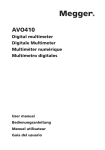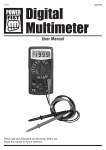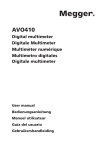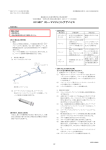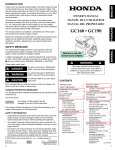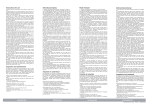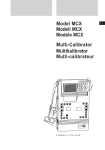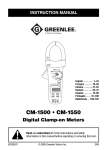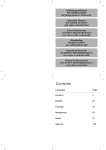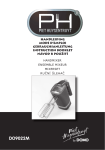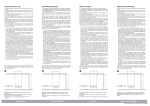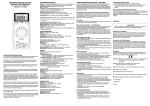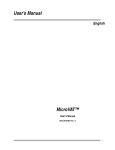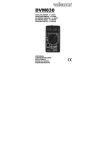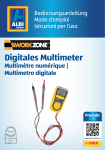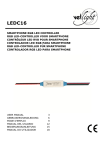Download AVO410
Transcript
mM AVO410 Digital multimeter Digitale Multimeter Multimèter numérique Multímetro digitales Digitale multimeter User manual Bedienungsanleitung Manuel utilisateur Guía del usuario Gebruikershandleiding 1 G SAFETY WARNINGS Safety warnings must be read and understood before instrument is used. The following safety information must be observed to insure maximum personal safety during the operation of this meter: ■ Do not use in wet environments. ■ Measurements beyond the maximum selected range must not be attempted. ■ Extreme care must be taken when measuring above 50 V, especially on live bus-bars. ■ To measure voltage, the instrument must not be switched to a current or resistance range, or to the diode check or buzzer position. ■ Circuits must be de-energised and isolated before carrying out resistance tests. ■ The rotary selector switch must only be turned after removing test connections. ■ All external voltages must be disconnected from the instrument before removing the battery. ■ Test leads and prods must be in good order, clean, and with no broken or cracked insulation. ■ UK Safety Authorities recommend the use of fused test leads when measuring voltage on high energy systems. ■ Replacement fuses must be of the correct type and rating. ■ The instrument must not be used if any part of it is damaged. ■ Check for correct instrument operation by testing a known voltage before and after use. Do not use if misleading results are obtained. ■ Warnings and precautions must be read and understood before an instrument is used.They must be observed during the operation of this instrument. CAT IV - Measurement category IV: Equipment connected between the origin of the low-voltage mains supply and the distribution panel. CAT III - Measurement category III: Equipment connected between the distribution panel and the electrical outlets. CAT II - Measurement category II: Equipment connected between the electrical outlet and the user’s equipment. Note This instrument must only be used by suitably trained and competent persons 2 Contents Safety warnings............................................................................................. 2 Symbols used on instrument......................................................................... 3 Introduction.................................................................................................. 4 Operation...................................................................................................... 5 Specifications.............................................................................................. 10 Manual de l’utilisateur ................................................................................ 16 Bedienungsanleitung .................................................................................. 30 Manual del usuario ..................................................................................... 44 Gebruikershandleiging................................................................................ 56 Symbols used on the instrument are: F G t c Caution: risk of electric shock Caution: refer to accompanying notes Equipment protected throughout by Double Insulation (Class II) Equipment complies with current EU directives. END OF LIFE DISPOSAL The crossed out wheeled bin placed on the Megger products is a reminder not to dispose of the product at the end of its product life with general waste. Megger is registered in the UK as a Producer of Electrical and Electronic Equipment.The Registration number is WEE/HE0146QT. BATTERIES Should the display fail to illuminate then change the battery. For the purpose of end of life disposal and battery replacement, removing the two screws on the base of the unit accesses the battery. The crossed out wheeled bin placed on the battery is a reminder not to dispose of it with general waste at the end of its life. This product contains 1 x PP3 / 6F22 alkaline battery. Do not use rechargeable batteries. The battery fitted in this instrument is classified as a Portable Battery and should be disposed of in the UK in accordance with Local Authority requirements. For disposal of batteries in other parts of the EU contact your local distributor. Megger is registered in the UK as a Producer of Batteries.The registration number is BPRN00142. 3 Introduction Thank you for purchasing the Megger AVO410 Digital Multimeter. For your own safety and to get the maximum benefit from your instrument, please ensure that you read and understand the safety warnings and instructions before attempting to use the instrument. The AVO410 is aimed at providing electricians with a rugged, easy to use multimeter for field use. Functions include voltage, current and resistance; in addition, there are extra functions that may also appeal to electrical and electronic engineers. The instrument features automatic or manual selection of ranges,True RMS readings and a CATIV 600 V safety rating. Unpacking and inspection Upon removing your new digital multimeter from its packing, you should have the following items. 1. Digital multimeter. 2.Test lead set (one black, on red) 3. User manual. 4. Protective holster. Symbols and annunciators Continuity A BAT Low battery ▲ Diode test HOLD Data hold AUTO Auto-ranging AC Alternating current or voltage DC Direct current or voltage MAX/MIN Stores the highest or lowest measurement J Backlight V Volts A, mA,uA Current range 4 Meter description 1. 6000 counts LCD display. 2. Push buttons for features 3. Selection switch 4. Input terminal for all other functions (Red) 5. Input terminal for A current selection (Red) 6. COM (Black) common or ground reference input terminal for all functions. Features 1 2 3 6 5 4 5 Operation AC VOLTAGE MEASUREMENTS 1. Set the function switch to the V AC position (AUTO,T-RMS and AC volts will appear on the display). 2. Insert the black test lead in the COM jack and the red test lead into the V jack. 3. Connect the test probe tips to the circuit under test. 4. Read the voltage on the display. DC VOLTAGE MEASUREMENTS 1. Set the function switch to the V DC position (AUTO and DC volts will be appear on the display). 2. Insert the black test lead into the COM jack and the red test lead into the V jack. 3. Connect the test probe tips to the circuit under test. Be sure to observe the correct polarity (red lead to positive, black lead to negative) 4. Read the voltage on the display. If the polarity is reversed, the display will show (-) minus before the reading. RESISTANCE (Ω) MEASUREMENTS 1. Set the function switch to the Ω position (AUTO and MΩ will appear on the display). 2. In addition, O.L will be displayed indicating an open circuit. 3. Insert the black test lead into the COM jack and the red test lead into the Ω jack. 4. Connect the test probe tips to the circuit under test. 5. According to measured value the reading will be in Ω, kΩ or MΩ. Note: The AVO410 provides an open circuit voltage <-1.5 V to the circuit under test which will cause transistor junctions to conduct so it is advisable to disconnect the item to be tested from the circuit to obtain an accurate reading. DIODE / CONTINUITY TESTS WARNING: To avoid electric shock never test a diode or conduct a continuity test on an energized circuit. 1. Set the function switch to the diode/continuity position. (The diode and V symbols will appear). 2. In addition, .OL will be displayed indicating an open circuit. 3. Insert the black test lead into the COM jack and the red test lead into the Ω jack. 6 4. For continuity connect the test probes to the cable or circuit to be tested. (Polarity is not important). 5. The AVO410 will emit a tone if continuity is below 500 Ω / .OL with no tone will indicate either open circuit or continuity above 500 Ω. 6. For diode testing connect the test probe tips to the diode or semiconductor junction and note the reading. 7. Reverse the probe polarity by switching probe position and note this reading. 8. The diode or junction can be evaluated as follows: a. If one reading shows a value and the other reading shows .OL, the diode is good. b. If both readings show .OL, the device is open circuit. c. If both readings are very small or zero, the device is shorted. DCµA MEASUREMENTS (6000 µA max.) 1. Set the function switch to the DCµA position. (AUTO and DCµA will be displayed). 2. Insert the black test lead into the COM jack and the red test lead into the µA jack. 3. Remove power from circuit under test, then open circuit at a convenient point where current is to be measured. 4. Connect the black test probe to the negative side of the circuit. Connect the red test probe to the positive side of the circuit. 5. Carefully apply the power 6. Read the measured on the display. 7. Remove supply before removing test leads and reconnecting circuit. CAPACITANCE MEASUREMENTS WARNING: To avoid damage to the instrument. Before testing, discharge the capacitor/s to be tested. 1. Set the function switch to the capacitor position (AUTO and nF will be appear on the display). 2. Insert the black test lead into the COM jack and the red test lead into the capacitance jack. 3. Connect the test probe tips to the capacitor under test. Be sure to observe the correct polarity if the capacitor is an electrolytic / polarised type. Red to positive and black to negative. 4. Read the value on the display. 7 FREQUENCY MEASUREMENTS 1. Set the function switch to the Hz position (AUTO and Hz will appear on the display). 2. Insert the black test lead in the COM jack and the red test lead into the Hz jack. 3. Connect the test probe tips to the circuit under test. 4. Read the frequency on the display. AC CURRENT MEASUREMENTS 1. Set the function switch to the AC A position. (AUTO,T-RMS and AC A will appear on the display). 2. Insert the black test lead into the COM jack and the red test lead into the A jack. 3. Remove power from circuit under test, then open circuit at a convenient point where current is to be measured. 4. Connect the black test probe to the negative side of the circuit. Connect the red test probe to the positive side of the circuit. 5. Carefully apply the power 6. Read the measured on the display. 7. Remove supply before removing test leads and reconnecting circuit. DC CURRENT MEASUREMENTS 1. Set the function switch to the DC A position. (AUTO and DC A will appear on the display). 2. Insert the black test lead into the COM jack and the red test lead into the A jack. 3. Remove power from circuit under test, then open circuit at a convenient point where current is to be measured. 4. Connect the black test probe to the negative side of the circuit. Connect the red test probe to the positive side of the circuit. 5. Carefully apply the power 6. Read the measured on the display. 7. Remove supply before removing test leads and reconnecting circuit. FEATURE BUTTONS BACKLIGHT The AVO410 has a backlit display for all the different functions which has an auto off in 60 seconds. 8 MIN MAX The MIN MAX function enables the user to display both a minimum and a maximum measured reading.To activate, first select a function and make a measurement. Press the MIN MAX button to store the maximum reading. Should the value increase then the new value will be stored. Pressing the MIN MAX button once more will switch the instrument display to minimum reading. Pressing the HOLD button while in MIN MAX mode will stop the AVO410 updating the maximum and minimum displayed reading. Holding down the MIN MAX button for >1 sec. will switch the function off. HOLD Press the HOLD button to freeze the reading on the display.The MIN MAX function is unavailable when the Hold is active. RS-232 With an optional USB adapter and software the AVO410 can be utilised with a computer to provide a virtual multimeter mode. RANGE When any of the individual functions are first selected the unit will be in the auto ranging mode. Each successive press of the range button will enable the operator to manually choose a required range. AUTO POWER OFF / DISABLE If the meter is idle for more than 10 minutes, the meter automatically turns the display off. During this off time the last reading on the meter is stored.The AVO410 can be restored by pressing any button. To disable the power off function simultaneously hold down the MIN MAX, RS232 and Range buttons and switch instrument to required function. 9 MAINTENANCE To clean the instrument, do not immerse in water, periodically wipe the case with a damp cloth and mild detergent. Dirt in the terminals may affect readings. Remove the battery if the AVO410 is not to be used for a long period of time. When the low battery symbol appears on the display, replace the battery. To replace battery remove instrument from black boot and unscrew two screws on battery cover to reveal battery. An internal user replaceable fuse can be accessed for replacement by unscrewing the four deep recess screws. Carefully separate the two halves of the tester taking care of battery lead. Use only the recommended replacement fuse (10 A 500 V 32 mm). SPECIFICATIONS General Specifications Display: 6000 counts updates 1.5/sec. Polarity indication: Automatic, positive implied, negative indicated Overrange indication: “OL” or “-OL” Low battery indication: Displayed when the battery voltage drops below operating voltage Auto power off: Approx 10 minutes Operating ambient: Non-condensing ≤10 °C, 11 °C ~ 30 °C (≤80% R.H) 31 °C ~ 40 °C (≤75% R.H), 41 °C ~ 50 °C (≤45% R.H) Storage temperature: -20 ºC to 60 ºC, 0 to 80% R.H. when battery removed from meter Temperature coefficient: 0.15 x (Spec.Acc’y) / ºC, <18 ºC or > 28 ºC Power requirements: Standard 9V battery NEDA 1604, IEC6F22, JIS006P Battery life: Alkaline 300 hours Dimensions (W x H x D): 76 mm x 158 mm x 38 mm without holster Weight: 10 522 g 82 mm x 164 mm x 44 mm with holster ELECTRICAL SPECIFICATIONS Accuracy is ± (% reading + number of digits) at 23 ºC ±5 ºC, less than 80% R.H DC/AC volts Range DC accuracy AC accuracy 600.0 mV 6.000 60.00 V ± (0.5% + 2 digits) 600.0 V DC 1000 V/AC 750 V 50 Hz/60 Hz sine wave only for 600.0 mV range, ± (0.9% + 5 digits) 50 Hz ~ 500 Hz *1 Over voltage protection: DC 1000 V or AC Input impedance: 10 MΩ // less than 100 pF CMRR/NMRR (Common mode rejection ration/normal mode rejection ratio) VAC: CMRR >60 dB at DC, 50 Hz/60 Hz VDC: CMRR >100 dB at DC, 50 Hz/60 Hz NMRR >50 dB at DC, 50 Hz/60 Hz AC conversion type: AC conversions are AC coupled True RMS responding, calibrated to the sine wave input. *1 The basic accuracy is specified for a sine wave below 4000 counts. Over 4000 counts, add 0.6% to the accuracy. For non-sine waves below 2000 counts, refer to the following for accuracy: ±1.5% addition error for C.F from1.4 to 3 Crest factor: C.F. = Peak/rms DC/AC current Range DC accuracy 600.0 µA 6000 µA 6.000 A 10.00 A AC accuracy N/A ± (1.0% + 2 digits) ±(1.5% +6 dgt) 50 Hz ~ 500 Hz *1 Voltage burden <4 mV/µA 2 V max 11 Overload protection A input: 10 A (500 V) fast blow fuse µA input: 600 V rms *1 AC conversion type: Conversion type and additional specification are the same as DC/AC voltage Resistance Range Accuracy Overload protection 600.0 Ω *2 6.000 KΩ 60.00 KΩ ± (0.7% + 2 digits) 600 V rms 600.0 KΩ 6.000 MΩ ± (1.0% + 2 digits) 60.00 MΩ *1 ± (1.5% + 2 digits) Open circuit voltage: -1.3 V approx. *1 <100 digit rolling *2 <10 digit rolling Diode check and continuity Range ▲ Resolution Accuracy 10 mV ± (1.5% + digits*) * For 0.4 V ~ 0.8 V Max. test current: 1.5 mA Max. open circuit voltage: 3V Overload protection: 600 V rms Continuity: Built-in buzzer will sound when the resistance is less than 500 Ω approx. Response time is 100 ms approx. 12 Frequency Range 6000 Hz 60.00 KHz **Sensitivity Overload protection 100 mV rms Frequency: 600.0 KHz * 6.000 MHz 250 mV rms 60.00 MHz 1 V rms Overload protection: 0.1% ±1 digit 600 V rms * Less than 20 Hz, the sensitivity is 1.5 V rms ** Max. sensitivity: <5 V ac rms Capacitance Range Accuracy 6.000 nF 60.00 nF 600.0 nF 6.000 µF ± (1.9%) +8 digits) 60.00 µF 600.0 µF 6.00 mF* Overload protection: 600 V rms * <100 digit of reading rolling Auto power off (APO): If idle for more than 10 minutes ACCESSORIES Battery (installed) Test leads User manual 13 REPAIR AND WARRANTY The instrument contains static sensitive devices, and care must be taken in handling the printed circuit board. If an instrument’s protection has been impaired it should not be used, but sent for repair by suitably trained and qualified personnel.The protection is likely to be impaired if for example; it shows visible damage; fails to perform the intended measurements; has been subjected to prolonged storage under unfavourable conditions, or has been subjected to severe transport stresses. Note: Any unauthorised prior repair or adjustment will automatically invalidate the warranty. INSTRUMENT REPAIR AND SPARE PARTS For service requirements for Megger instruments contact: Megger Limited or Megger Archcliffe Road Valley Forge Corporate Centre Dover2621 Van Buren Avenue Kent CT17 9EN Norristown PA 19403 England. U.S.A. Tel: +44 (0) 1304 502 243 Tel: +1 610 676 8579 Fax: +44 (0) 1304 207 342 Fax: +1 610 676 8625 or an approved repair company. Returning and Instrument for Repair If it is necessary to return an instrument for repair, a Returns Authorisation number must first be obtained by contacting one of the addresses shown.You will be asked to provide key information, such as the instrument serial number and fault reported when the number is issued.This will enable the Service Department to prepare in advance for the receipt of your instrument, and to provide the best possible service to you. The Returns Authorisation number should be clearly marked on the outside of the product packaging, and on any related correspondence.The instrument should be sent, freight paid to the appropriate address. If appropriate a copies of the original purchase invoice and of the packing note, should be sent simultaneously by airmail to expedite clearance through customs. For instruments requiring repair outside the warranty period a repair estimate will be submitted to the sender, if required, before work on the instrument commences. 14 Approved Repair Companies A number of independent instrument repair companies have been authorised for repair work on most Megger instruments, using genuine Megger spare parts. A list of approved companies is available from the UK address shown. 15 G AVERTISSEMENTS DE SECURITE Il est impératif de lire et comprendre les avertissements de sécurité avant d’utiliser l’instrument. Pour assurer une sécurité individuelle maximum pendant le fonctionnement de cet instrument de mesure, il faut observer rigoureusement les informations de sécurité ci-après : ■ Ne pas l’utiliser dans des environnements humides. ■ Ne pas tenter de mesurer au-delà du maximum de la gamme sélectionnée. ■ Apporter un soin extrême en mesurant des valeurs au-dessus de 50 V, particulièrement sur les barres omnibus de phase. ■ Pour mesurer la tension, l’instrument ne doit pas être commuté sur une gamme de mesure de courant ou de résistance, ou sur le contrôle de diode ou sur la position vibreur. ■ Les circuits doivent être hors tension et isolés avant d’effectuer les tests de résistance. ■ Le sélecteur rotatif ne doit être tourné qu’après le retrait des connexions de test. ■ Toutes les tensions externes doivent être déconnectées de l’instrument avant d’enlever la batterie. ■ Les cordons de test et les pointes de touche doivent être dans le bon ordre, propres, et sans isolation cassée ou craquelée. ■ Les autorités du Royaume Uni pour la sécurité, recommandent l’utilisation de cordons de test équipés de fusibles pour la mesure de tension sur les systèmes de haute énergie. ■ Les fusibles de remplacement doivent être de type et de caractéristiques nominales correctes. ■ L’instrument ne doit pas être utilisé si l’une de ses parties est endommagée. ■ Vérifier le fonctionnement correct de l’instrument en testant une tension connue, avant et après usage. Ne pas l’utiliser si des résultats fallacieux sont obtenus. ■ Les avertissements et les précautions doivent être lus et compris avant qu’un instrument soit utilisé. Ils doivent être observés pendant le fonctionnement de cet instrument. Note Cet instrument ne doit être utilisé que par des personnes convenablement qualifiées et compétentes 16 CAT II - Mesure catégorie II : équipement connecté entre les prises de courant et l’équipement de l’utilisateur. CAT III - Mesure catégorie III : équipement connecté entre le tableau électrique et les prises de courant. CAT IV - Mesure catégorie IV : équipement connecté entre la source d’alimentation électrique à basse tension et le tableau Les symboles utilisés sur l’instrument sont : F G t c Attention : Risque de choc électrique Attention: se reporter aux notes d’accompagnement Équipement protégé partout par double isolement (Classe II) L’équipement est conforme aux directives EU actuelles. Introduction Merci pour l’achat du multimètre numérique Megger AVO410. Pour votre propre sécurité et pour obtenir l’avantage maximum de votre instrument, faites le nécessaire pour lire et comprendre les avertissements et les instructions de sécurité avant d’essayer d’utiliser l’instrument. L’AVO410 a été conçu pour fournir aux électriciens un multimètre de chantier, robuste et facile d’emploi. Les fonctions incluent la tension, le courant et la résistance ; en outre, il y a des fonctions supplémentaires qui peuvent également faire appel aux ingénieurs électriciens et électroniciens. L’instrument comporte la sélection automatique ou manuelle des gammes, des lectures RMS (valeurs efficaces) vraies et une valeur nominale de sécurité CATIV 600 V. Déballage et inspection En retirant votre nouveau multimètre numérique de son emballage, vous devez trouver les articles suivants. 1. Multimètre numérique. 2. Un jeu de cordon de test (un noir, un rouge) 3. Un guide d’utilisation 4. Un étui protecteur. 17 Symbols and annunciators ContinuitéA BAT Batterie faible ▲ Test pour diode HOLD Maintien des données AUTO Sélection automatique de gamme AC Tension ou courant alternatif DC Courant ou tension continu MAX/MIN Stocke la mesure la plus élevée ou la plus basse J Rétro-éclairage V Volts A, mA,uA Gamme de courant Description de l’instrument de mesure 1. Affichage à cristaux liquides de 6000 points. 2. Boutons poussoirs pour les fonctions 3. Commutateur de sélection 4. Borne d’entrée pour toutes les autres fonctions (Rouge) 5. Borne d’entrée pour la sélection de courant A (Rouge) 6. COM (Noir) borne d’entrée de référence commune ou de terre pour toutes les fonctions. 18 Fonctions 1 2 3 6 5 4 Fonctionnement MESURE DES TENSIONS CA 1. Placer le commutateur de fonction sur la position V AC pour les volts CA [AUTO,T-RMS (valeurs efficaces vraies) et AC volts apparaîtront sur l’afficheur]. 2. Insérer le cordon de test noir dans le jack COM et le cordon de test rouge dans le jack V. 3. Connecter les pointes de touche au circuit à tester. 4. Lire la tension sur l’afficheur. 19 MESURE DES TENSIONS CC 1. Placer le commutateur de fonction sur la position V DC pour les volts CC (AUTO et DC volts apparaîtront sur l’afficheur). 2. Insérer le cordon de test noir dans le jack COM et le cordon de test rouge dans le jack V. 3. Connecter les pointes de touche au circuit à tester. Veiller à respecter les polarités correctes (le cordon rouge au « plus » et le cordon noir au « moins ») 4. Lire la tension sur l’afficheur. Si la polarité est inversée, l’affichage montrera le moins (-) avant la lecture. MESURE DE RESISTANCE (Ω) 1. Placer le commutateur de fonction sur la position Ω (AUTO et MΩ apparaîtront sur l’afficheur). 2. De plus, O.L sera affiché pour indiquer un circuit ouvert. 3. Insérer le cordon de test noir dans le jack COM et le cordon de test rouge dans le jack Ω. 4. Connecter les pointes de test au circuit à tester. 5. Selon la valeur à mesurer, la lecture sera en Ω, kΩ ou MΩ. Note : L’AVO410 fournit une tension de circuit ouvert < - 1,5 V au circuit en test, ce qui causera la conduction des jonctions du transistor, aussi est-il recommandé de déconnecter l’article à examiner du circuit pour obtenir une lecture précise. DIODE / TESTS DE CONTINUITE AVERTISSEMENT : Pour éviter le choc électrique ne jamais examiner une diode ou effectuer un essai de continuité sur un circuit sous tension. 1. Placer le commutateur de fonction dans la position « diode/continuité ». (le symbole V et le symbole de la diode apparaîtront). 2. De plus, OL sera affiché pour indiquer un circuit ouvert. 3. Insérer le cordon de test noir dans le jack COM et le cordon de test rouge dans le jack Ω. 4. Pour la continuité, connecter les pointes de touche au câble ou au circuit à tester. (La polarité n’est pas importante). 5. L’AVO410 émettra une tonalité si la continuité est en-dessous de 500 Ω / .OL sans tonalité indiquera soit un circuit ouvert ou la continuité au-dessus de 500 Ω. 6. Pour le test de diode connecter les pointes de touche à la jonction de diode 20 ou de semi-conducteur et noter la lecture. 7. Inverser la polarité de la sonde en commutant la position de sonde et noter cette lecture. 8. La diode ou la jonction peuvent être évalués comme suit : a. Si une lecture indique une valeur et que l’autre lecture indique OL, la diode est bonne. b. Si les deux lectures indiquent .OL, l’équipement est un circuit ouvert. c. Si les deux lectures sont très petites ou pratiquement zéro, le dispositif est en court-circuit. MESURES µACC (6000 µA MAX.) 1. Placer le commutateur de fonction sur la position DCμA (μACC). (AUTO et DCμA s’afficheront). 2. Insérer le cordon de test noir dans le jack COM et le cordon de test rouge dans le jack μA. 3. Couper la puissance sur le circuit en test, puis ouvrir le circuit en un point commode où le courant doit être mesuré. 4. Connecter la pointe de touche noire au coté négatif du circuit Connecter la pointe de touche rouge au coté positif du circuit. 5. Appliquer la puissance avec précaution 6. Lire la mesure sur l’afficheur. 7. Retirer l’alimentation avant d’enlever les cordons de test et de rebrancher le circuit. MESURES DE CAPACITÉ AVERTISSEMENT : Pour éviter d’endommager l’instrument. Avant le test, décharger le/s capacités/s à tester. 1. Placer le commutateur de fonction sur la position réservée aux capacités (AUTO et nF apparaîtront sur l’afficheur). 2. Insérer le cordon de test noir dans le jack COM et le cordon de test rouge dans le jack pour capacité. 3. Connecter les pointes de touche au condensateur en test. Vérifier, si le condensateur est de type électrolytique/polarisé, que la polarité est bien respectée. Le rouge coté positif et le noir coté négatif. 4. Lire la valeur sur l’afficheur. MESURES DE FREQUENCE 1. Placer le commutateur de fonction sur la position Hz (AUTO et Hz apparaîtront sur l’afficheur). 2. Insérer le cordon de test noir dans le jack COM et le cordon de test rouge dans le jack Hz. 3. Connecter les pointes de touche au circuit en test. 21 4. Lire la fréquence sur l’afficheur. MESURES DE COURANT CA 1. Placer le commutateur de fonction sur la position AC A (A pour courant ca). (AUTO,T-RMS et AC A apparaîtront sur l’afficheur). 2. Insérer le cordon de test noir dans le jack COM et le cordon de test rouge dans le jack A. 3. Couper la puissance sur le circuit en test, puis ouvrir le circuit en un point commode où le courant doit être mesuré. 4. Connecter la pointe de touche noire au côté négatif du circuit. Connecter la pointe de touche rouge au côté positif du circuit. 5. Appliquer la puissance avec précaution 6. Lire la valeur mesurée sur l’afficheur. 7. Retirer l’alimentation avant d’enlever les cordons de test et de reconnecter le circuit. MESURES DE COURANT CC 1. Placer le commutateur de fonction sur la position DC A (A pour courant cc). (AUTO et DC A apparaîtront sur l’afficheur). 2. Insérer le cordon de test noir dans le jack COM et le cordon de test rouge dans le jack A. 3. Couper la puissance sur le circuit en test puis ouvrir le circuit en un point commode où le courant doit être mesuré. 4. Connecter la pointe de touche noire d’essai au côté négatif du circuit. Connecter la pointe de touche rouge au côté positif du circuit. 5. Appliquer la puissance avec précaution 6. Lire la valeur mesurée sur l’afficheur. 7. Retirer l’alimentation avant de retirer les cordons de test et de reconnecter le circuit. 22 BOUTONS DE FONCTIONS BACKLIGHT (RETRO-ECLAIRAGE) L’AVO410 a un affichage rétro-éclairé pour toutes les différentes fonctions, qui s’éteint automatiquement en 60 secondes. MIN MAX La fonction MIN MAX permet à l’utilisateur d’afficher le minimum et le maximum d’une valeur mesurée. Pour activer, choisir en premier une fonction et faire une mesure. Appuyer sur le bouton MIN MAX pour stocker la lecture maximum. Si augmentation de valeur il y a, alors la nouvelle valeur sera stockée. Appuyer une fois de plus sur le bouton MIN MAX pour afficher la lecture minimum. En appuyant sur le bouton HOLD (maintien) en mode MIN MAX, l’AVO410 arrêtera la mise à jour du maximum et du minimum de la lecture affichée. En maintenant enfoncé le bouton MIN MAX pour > 1 seconde, la fonction s’éteindra. HOLD (FONCTION DE MAINTIEN DE LA MESURE) Presser le bouton HOLD pour geler la lecture sur l’afficheur. La fonction MIN MAX est indisponible lorsque la fonction HOLD est activée. RS-232 Avec un adaptateur USB facultatif et un logiciel, l’AVO410 peut être utilisé avec un ordinateur pour fournir un mode de multimètre virtuel. RANGE (GAMME) Pour n’importe laquelle des fonctions individuelles sélectionnée en premier, l’unité est en mode de sélection automatique de gamme. Chaque pression successive du bouton de gamme, permettra à l’opérateur de choisir manuellement la gamme requise. AUTO POWER OFF / DISABLE (fonction d’extinction automatique/neutralisée) Si l’appareil de mesure est inactif pendant plus de 10 minutes, il arrête automatiquement l’affichage. Pendant cette pause, la dernière lecture de l’appareil est stockée. L’AVO410 peut être rétabli en appuyant sur n’importe quel bouton. Pour neutraliser la fonction d’extinction automatique, maintenir pressés simultanément les boutons MIN MAX, RS232 et Range et commuter l’instrument à la fonction requise. 23 MAINTENANCE Pour nettoyer l’instrument, ne pas l’immerger dans l’eau, essuyer périodiquement le boîtier avec un tissu humide et un détergent doux. La saleté dans les bornes peut affecter des lectures. Enlever la batterie si l’AVO410 ne doit pas être employé pendant une longue période. Quand le symbole de batterie faible apparaît sur l’affichage, remplacer la batterie. Pour remplacer la batterie enlever l’instrument de la protection noire et dévisser les deux vis sur le couvercle de batterie. Un fusible interne, remplaçable par l’utilisateur est accessible en dévissant les quatre vis profondes à tête fraisée. Séparer avec précaution les deux moitiés de l’appareil de contrôle en prenant soin du câble de batterie. Utiliser seulement le fusible de remplacement recommandé (10 A 500 V 32 mm). SPECIFICATIONS Spécifications générales Affichage: 6000 points, mises à jour 1,5/sec. Indication de polarité: Automatique, positif implicite, négatif indiqué Indication de dépassement de gamme : « OL » ou « -OL » Indication de batterie faible : Affichée quand la tension de batterie chute au-dessous de la tension de fonctionnement Extinction automatique : 10 minutes approximativement Température ambiante : Sans condensation ≤10 °C, 11 °C ~ 30 °C (≤80% H.R) 31 °C ~ 40 °C (≤ 75% H.R), 41 °C ~ 50 °C (≤45% H.R) Température de stockage : -20 ºC à 60 ºC, 0 à 80% H.R. quand la batterie est enlevée de l’appareil Coefficient de température : 0,15 x (Spéc.Acc’y) / ºC, <18 ºC ou > 28 ºC 24 Alimentation électrique : Batterie standard de 9V NEDA 1604, IEC6F22, JIS006P Autonomie de la batterie : 300 heures pour batterie alcaline Dimensions (Largeur x Hauteur x Profondeur) : 76 mm x 158 mm x 38 mm sans étui 82 mm x 164 mm x 44 mm avec étui Poids : 522 g SPECIFICATIONS ELECTRIQUES La précision est de ± (% de la lecture + nombre de chiffres) à 23º C ± 5 º C, avec moins de 80% H.R Volts CC/CA Gamme Précision en courant continu (CC) 600.0 mV 6.000 60.00 V ± (0.5% + 2 chiffres) 600.0 V 1000 Vcc/750 Vca Précision en courant alternatif (CA) Onde sinusoïdale de 50 Hz/60 Hz uniquement pour la gamme 600,0 mV, ± (0,9% + 5 chiffres) 50 Hz ~ 500 Hz *1 Protection contre la surtension: 1000 Vcc ou 1000 Vca Impédance d’entrée: 110 MΩ // moins de 100 pF TRMC/TRMN (CMRR/NMRR) (Taux de réjection de mode commun/taux de réjection de mode normal) VCA: TRMC >60 dB à CC, 50 Hz/60 Hz VCC : TRMC >100 DB À CC, 50 HZ/60 HZ TRMN >50 DB À CC, 50 HZ/60 HZ Type de conversion C.A. Réponse CA : valeur efficace vraie (TRMS), calibrée à l’entrée de l’onde sinusoïdale. 25 *1 La précision de base est indiquée pour une onde sinusoïdale en-dessous de 4000 points. Au-dessus de 4000 points, additionner 0,6% à la précision. Pour les ondes sinusoïdales en-dessous de 2000 points, se référer à la précision ci-après : Erreur d’addition de ± 1,5% pour le F.C (facteur de crête) de 1,4 à 3 Facteur de crête : F.C. = Pic/valeur efficace (rms) Courant CC/CA Gamme Précision en CC Précision en CA 600.0 µA 6000 µA 6.000 A 10.00 A ± (1.0% + 2 chiffres) Charge de tension Sans objet <4 mV/µA ±(1.5% +6 chiffres)50 Hz ~ 500 Hz *1 2 V max Protection contre les surcharges Entrée A: Fusible rapide10 A (500 V) Entrée μA: 600 V efficaces *1 Type de conversion CA: Le type de conversion et la spécification supplémentaire sont les mêmes pour les tensions CC/CA Résistance Gamme Précision Protection contre les surcharges 600.0 Ω *2 6.000 KΩ 60.00 KΩ ± (0.7% + 2 chiffres) 600 V efficaces 600.0 KΩ 6.000 MΩ ± (1.0% + 2 chiffres 60.00 MΩ *1 ± (1.5% + 2 chiffres) 26 Tension en circuit ouvert: -1.3 V approx. *1 <défilement à 100 chiffres *2 <défilement à 10 chiffres Vérification de diode et continuité Gamme ▲ Résolution Précision 10 mV ± (1.5% + chiffres*) * Pour 0,4 V ~ 0,8 V Courant de test maximal: 1,5 mA Tension maximale circuit ouvert : 3V Protection contre les surcharges : 600 V efficaces Continuité Le vibreur intégré retentira quand la résistance est inférieure à 500 Ω approximativement. Le temps de réponse est approximativement de 100 ms. Fréquence Gamme 6000 Hz 60.00 KHz **Sensibilité surcharges Protection contre les 100 mV efficaces Fréquence : 600.0 KHz 0,1% ±1 chiffre 6.000 MHz 250 mV efficaces 60.00 MHz 1 V efficaces Protection contre les surcharges: 600 V efficaces * en-dessous de 20 Hz, la sensibilité est de 1,5 V efficace ** Sensibilité maximale: <5 V ca efficaces 27 Capacité Gamme Précision 6.000 nF 60.00 nF 600.0 nF 6.000 µF ± (1.9%) 60.00 µF +8 chiffres) 600.0 µF 6.00 mF* Protection contre les surcharges : 600 V efficaces * < défilement à 100 chiffres Extinction automatique (APO): Si au repos pour plus de 10 minutes ACCESSOIRES Batterie (installée) Cordons de test Manuel de l’utilisateur REPARATION ET GARANTIE L’appareil contient des composants sensibles à l’électricité statique. La carte du circuit imprimé doit être manipulée avec précaution. Si le système de protection interne d’un appareil est altéré, celui-ci ne doit plus être utilisé. Le faire réparer par des personnes habilitées et formées de façon adéquate. La protection interne peut être considérée comme altérée lorsque, par exemple, l’appareil présente des défaut visibles, qu’il n’est plus capable d’effectuer les mesures pour lesquelles il est prévu, qu’il a subi un stockage prolongé dans des conditions défavorables ou qu’il a été soumis a des contraintes violentes durant son transport. Note: Toute réparation ou réglage préalablement non autorisé annulera automatiquement la garantie. 28 REPARATION DE L’INSTRUMENT ET PIECES DE RECHANGE Pour toute demande d’intervention sur des appareils Megger, contacter : Megger Limited or Megger SARL Archcliffe Road Z.A. Du Buisson de la Couldre Dover 23 rue Eugène Henaff Kent CT17 9EN 78190 TRAPPES France Tel: +44 (0) 1304 502 243 Tel: +33 (0)1 30.16.08.90 Fax: +44 (0) 1304 207 342 Fax: +33 (0)1 34.61.23.77 ou un service de réparation agréé. Renvoyer un instrument pour réparation S’il est nécessaire de retourner un instrument pour réparation, un numéro d’autorisation pour renvoi doit d’abord être obtenu en contactant l’une des adresses indiquées. Vous serez invité à fournir des informations principales, telles que le numéro de série de l’instrument et les défauts rapportés, une fois le numéro émis. Ceci permettra au service après vente de préparer à l’avance la réception de votre instrument, et de vous fournir le meilleur service. Le numéro d’autorisation de renvoi doit être clairement marqué sur l’extérieur de l’emballage, et sur n’importe quelle correspondance afférente. L’instrument doit être envoyé, fret payé à l’adresse appropriée. Si approprié, les copies de la facture originale de l’achat et de la note d’emballage doivent être envoyées simultanément par avion pour le dédouanement. Pour les instruments nécessitant une réparation en dehors de la période de garantie, une estimation de la réparation sera soumise à l’expéditeur, s’il y a lieu, avant que le travail sur l’instrument ne débute. Entreprises de réparation agréées Un certain nombre d’entreprises de réparation d’instruments indépendantes ont été approuvées pour des travaux de réparation sur la plupart des instruments Megger, à l’aide de pièces détachées Megger authentiques. Une liste de compagnies approuvées est disponible auprès de l’adresse du Royaume Uni affichée. 29 G SICHERHEITSWARNHINWEISE Sicherheitswarnhinweise müssen vor der Verwendung des Instruments gelesen und verstanden werden. Die folgenden Sicherheitsangaben müssen beachtet werden, um während des Betriebs des vorliegenden Messgeräts für maximale Personalsicherheit zu sorgen. ■ Nicht in feuchten Umgebungen einsetzen. ■ Es dürfen keine Messungen außerhalb des maximalen ausgewählten Bereichs durchgeführt werden. ■ Bei Messungen über 50 V ist mit extremer Vorsicht vorzugehen, insbesondere bei der Messung an stromführenden Sammelschienen. ■ Das Instrument darf zum Messen der Spannung weder auf einen Strom- oder Widerstandsbereich noch auf die Diodenprüf- oder Summerposition umgeschaltet werden. ■ Schaltkreise müssen stromlos gemacht und isoliert werden, bevor Widerstandstests durchgeführt werden. ■ Der Auswahldrehschalter darf erst nach dem Trennen der Testverbindungen gedreht werden. ■ Alle externen Spannungen müssen vom Instrument getrennt werden, bevor die Batterie entnommen wird. ■ Testleitungen und Produkte müssen ordnungsgemäß, sauber und ohne beschädigte oder von Rissen durchzogene Isolation sein. ■ Die britischen Sicherheitsbehörden empfehlen die Verwendung von abgesicherten Testleitungen zum Messen der Spannung von Hochleistungssystemen. ■ Ersatzsicherungen müssen den richtigen Typ und die entsprechende Klassifizierung aufweisen. ■ Das Instrument darf nicht benutzt werden, wenn irgendein Teil beschädigt ist. ■ Vor und nach der Verwendung durch Messen einer bekannten Spannung den einwandfreien Betrieb des Instruments prüfen. Bei irreführenden Ergebnis sen das Instrument nicht verwenden. ■ Sicherheitswarnhinweise und Vorsichtshinweise müssen vor der Verwendung eines Instruments gelesen und verstanden werden. Sie sind während des Betriebs dieses Instruments zu beachten. CAT II - Bewertungskategorie II: Ausrüstung, die zwischen den Steckdosen und der Aurüstung des Benutzers angeschlossen ist. CAT III - Bewertungskategorie III: Ausrüstung, die zwischen dem Verteilerkasten und den Steckdosen angeschlossen ist. CAT IV - Bewertungs-kategorie IV: Ausrüstung, die zwischen dem Ursprung des Niederspannungsnetzes und dem Verteilerkasten angeschlossen ist. 30 Hinweis - Das Instrument darf nur von ausreichend geschulten und qualifizierten Personen verwendet werden Folgende Symbole werden auf diesem Gerät verwendet: F Vorsicht: Risiko von Elektroschock G Vorsicht: siehe begleitende Erläuterungen t Ausrüstung vollständig durch doppelte Isolierung (Klasse II) geschützt c Die Ausrüstung entspricht den geltenden EU-Richtlinien. Einleitung Vielen Dank für den Erwerb des digitalen Multimeters AVO410. Für Ihre eigene Sicherheit und um Ihr Instrument optimal zu nutzen, lesen Sie sich bitte vor der Verwendung des Instruments unbedingt die Sicherheitswarnhinweise und die Anleitung gründlich durch. Der AVO410 ist ein robuster, leicht bedienbarer Multimeter für den Außeneinsatz durch Elektriker. Zu seinen Funktionen zählen Spannung, Strom und Widerstand; einige Sonderfunktionen könnten Elektrikern und Elektrotechnikern ebenfalls gefallen. Dieses Instrument ermöglicht die automatische oder manuelle Bereichsauswahl,True-RMS-Messanzeigen und eine Sicherheitsbemessung für CATIV 600 V. Auspacken und untersuchen Nach dem Entnehmen Ihres neuen digitalen Multimeters aus seiner Verpackung sollten Ihnen folgende Artikel vorliegen. 1. Digitaler Multimeter 2. Prüfkabelsatz (eins schwarz, eins rot) 3. Bedienungsanleitung 4. Schutztasche Symbole und Hinweiszeichen Kontinuität A BAT Batterie erschöpft ▲ Diodentest HOLD Daten halten AUTO Automatische Bereichseinstellung AC Wechselstrom oder -spannung DC Gleichstrom oder -spannung MAX/MIN J Speichert die höchste oder niedrigste Messung Hintergrundbeleuchtung 31 V Volts A, mA,uA Strombereich Beschreibung des Messgeräts 1. LCD-Display mit 6000 Zählimpulsen 2. Drucktasten für Funktionen 3. Auswahlschalter 4. Eingangsanschluss für alle anderen Funktionen (Rot) 5. Eingangsanschluss für Stromauswahl A (Rot) 6. COM (Schwarz) Gemeinsamer oder Bezugserde-Eingangsanschluss für alle Funktionen. Funktionen 1 2 3 6 5 Bedienung WECHSELSPANNUNGSMESSUNGEN 32 4 1. Setzen Sie den Funktionsschalter in die Position V AC (auf dem Display erscheinen AUTO,T-RMS und AC-Volt). 2. Stecken Sie das schwarze Prüfkabel in die COM-Buchse und das rote Prüfkabel in die V-Buchse. 3. Schließen Sie die Prüfsondenspitzen an den zu prüfenden Stromkreis an. 4. Lesen Sie die Spannung auf dem Display ab. GLEICHSPANNUNGSMESSUNGEN 1. Setzen Sie den Funktionsschalter in die Position V DC (auf dem Display erscheinen AUTO und DC-Volt). 2. Stecken Sie das schwarze Prüfkabel in die COM-Buchse und das rote Prüfkabel in die V-Buchse. 3. Schließen Sie die Prüfsondenspitzen an den zu prüfenden Stromkreis an. Achten Sie darauf, die richtige Polarität einzuhalten (rotes Kabel an positiv, schwarzes Kabel an negativ) 4. Lesen Sie die Spannung auf dem Display ab. Bei Umkehr der Polarität zeigt das Display ein Minus (-) vor der Messanzeige. WIDERSTANDSMESSUNGEN (Ω) 1. Setzen Sie den Funktionsschalter in die Position Ω (auf dem Display erscheinen AUTO und MΩ). 2. Außerdem wird O.L angezeigt, was auf einen offenen Stromkreis hinweist. 3. Stecken Sie das schwarze Prüfkabel in die COM-Buchse und das rote Prüfkabel in die Ω-Buchse. 4. Schließen Sie die Prüfsondenspitzen an den zu prüfenden Stromkreis an. 5. Die Anzeige erfolgt in Ω, kΩ oder MΩ, je nach dem gemessenen Wert. Hinweis: Der AVO410 liefert eine Leerlaufspannung von < -1,5 V an den geprüften Stromkreis, was die Transistorsperrschicht leitend macht; daher sollte das geprüfte Objekt vom Stromkreis getrennt werden, um eine genaue Messung zu erhalten. DIODEN-/KONTINUITÄTSPRÜFUNGEN WARNUNG: Niemals eine Diode prüfen oder eine Kontinuitätsprüfung an einem Strom führenden Stromkreis durchführen, um Elektroschocks zu vermeiden. 1. Setzen Sie den Funktionsschalter in die Position Diode/Kontinuität. (Die Symbole für Diode und V erscheinen.) 2. Außerdem wird .OL angezeigt, was auf einen offenen Stromkreis hinweist. 3. Stecken Sie das schwarze Prüfkabel in die COM-Buchse und das rote Prüfkabel in die Ω-Buchse. 33 4. Schließen Sie für eine Kontinuitätsprüfung die Prüfsonden an das zu prüfende Kabel oder den Stromkreis an. (Die Polarität spielt keine Rolle.) 5. Der AVO410 erzeugt einen Ton, wenn die Kontinuität unter 500 Ω liegt. /.OL ohne Ton weist entweder auf einen offenen Stromkreis oder eine Kontinuität über 500 Ω hin. 6. Schließen Sie die Prüfsondenspitzen für eine Diodenprüfung an die Diode oder Halbleitersperrschicht an und notieren Sie sich den Messwert. 7. Kehren Sie die Sondenpolarität durch Wechseln der Sondenposition um und notieren Sie sich den Messwert. 8. Die Diode oder die Sperrschicht lässt sich wie folgt auswerten: a. Wenn eine Messanzeige einen Wert zeigt und die andere Messan zeige .OL zeigt, ist die Diode in Ordnung. b. Wenn beide Messanzeigen .OL zeigen, befindet sich das Gerät im Leerlaufzustand. c. Wenn beide Messanzeigen sehr klein oder null sind, ist das Gerät kurzgeschlossen. DCµA-MESSUNGEN (6000 µA MAX.) 1. Setzen Sie den Funktionsschalter in die Position DCμA. (AUTO und DCμA werden angezeigt.) 2. Stecken Sie das schwarze Prüfkabel in die COM-Buchse und das rote Prüfkabel in die μA-Buchse. 3. Schalten Sie die Stromversorgung des geprüften Stromkreises ab und öffnen Sie den Stromkreis an einem passenden Punkt, an dem der Strom gemessen werden soll. 4. Schließen Sie die schwarze Prüfsonde an die negative Seite des Kreises an. Schließen Sie die rote Prüfsonde an die positive Seite des Kreises an. 5. Legen Sie vorsichtig Leistung an. 6. Lesen Sie Messung auf dem Display ab. 7. Schalten Sie die Stromversorgung ab, bevor Sie die Prüfkabel entfernen und den Stromkreis wieder verbinden. KAPAZITÄTSMESSUNGEN WARNUNG: So vermeiden Sie Schäden am Instrument. Entladen Sie vor dem Prüfen den oder die zu prüfenden Kondensatoren. 1. Setzen Sie den Funktionsschalter in die Kondensatorposition (auf dem Display erscheinen AUTO und nF). 2. Stecken Sie das schwarze Prüfkabel in die COM-Buchse und das rote Prüfkabel in die Kapazitätsbuchse. 3. Schließen Sie die Prüfsondenspitzen an den zu prüfenden Kondensator an. Achten Sie darauf, die richtige Polarität einzuhalten, wenn es sich um einen 34 elektrolytischen/polarisierten Kondensator handelt. Rot an positiv und schwarz an negativ. 4. Lesen Sie den Wert auf dem Display ab. FREQUENZMESSUNGEN 1. Setzen Sie den Funktionsschalter in die Position Hz (auf dem Display erscheinen AUTO und Hz). 2. Stecken Sie das schwarze Prüfkabel in die COM-Buchse und das rote Prüfkabel in die Hz-Buchse. 3. Schließen Sie die Prüfsondenspitzen an den zu prüfenden Stromkreis an. 4. Lesen Sie die Frequenz auf dem Display ab. WECHSELSTROMMESSUNGEN 1. Setzen Sie den Funktionsschalter in die Position AC A. (Auf dem Display erscheinen AUTO,T-RMS und AC A.) 2. Stecken Sie das schwarze Prüfkabel in die COM-Buchse und das rote Prüfkabel in die A-Buchse. 3. Schalten Sie die Stromversorgung des geprüften Stromkreises ab und öffnen Sie den Stromkreis an einem passenden Punkt, an dem der Strom gemessen werden soll. 4. Schließen Sie die schwarze Prüfsonde an die negative Seite des Kreises an. Schließen Sie die rote Prüfsonde an die positive Seite des Kreises an. 5. Legen Sie vorsichtig Leistung an. 6. Lesen Sie Messung auf dem Display ab. 7. Schalten Sie die Stromversorgung ab, bevor Sie die Prüfkabel entfernen und den Stromkreis wieder verbinden. GLEICHSTROMMESSUNGEN 1. Setzen Sie den Funktionsschalter in die Position DC A. (Auf dem Display erscheinen AUTO und DC A.) 2. Stecken Sie das schwarze Prüfkabel in die COM-Buchse und das rote Prüfkabel in die A-Buchse. 3. Schalten Sie die Stromversorgung des geprüften Stromkreises ab und öffnen Sie den Stromkreis an einem passenden Punkt, an dem der Strom gemessen werden soll. 4. Schließen Sie die schwarze Prüfsonde an die negative Seite des Kreises an. Schließen Sie die rote Prüfsonde an die positive Seite des Kreises an. 5. Legen Sie vorsichtig Leistung an. 6. Lesen Sie Messung auf dem Display ab. 7. Schalten Sie die Stromversorgung ab, bevor Sie die Prüfkabel entfernen und den Stromkreis wieder verbinden. 35 FUNKTIONSTASTEN HINTERGRUNDBELEUCHTUNG Der AVO410 verfügt über ein Display mit Hintergrundbeleuchtung für die unterschiedlichen Funktionen, die sich nach 60 Sekunden automatisch ausschaltet. MIN MAX Die Funktion MIN MAX erlaubt es dem Benutzer, sowohl einen minimalen als auch einen maximalen Messwert anzuzeigen. Um die Funktion zu aktivieren, wählen Sie zunächst eine Funktion aus und nehmen Sie eine Messung vor. Drücken Sie die Taste MIN MAX, um den maximalen Messwert zu speichern. Falls sich der Wert erhöht, wird der neue Wert gespeichert. Ein erneutes Drücken der Taste MIN MAX schaltet die Instrumentenanzeige auf den minimalen Messwert. Wird die HOLD-Taste im MIN MAX-Modus gedrückt, hört der AVO410 auf, die maximalen und minimalen Anzeigemesswerte zu aktualisieren. Durch Gedrückthalten der Taste MIN MAX für eine mehr als 1 Sekunde wird die Funktion ausgeschaltet. HALTEN Drücken Sie die HOLD-Taste, um die Messanzeige auf dem Display einzufrieren. Die Funktion MIN MAX ist nicht verfügbar, wenn Halten aktiv ist. RS-232 Mit einem optionalen USB-Adapter und Software kann der AVO410 mit einem Computer zusammen verwendet werden und einen virtuellen MultimeterModus bereitstellen. BEREICH Beim erstmaligen Auswählen einer der verschiedenen Funktionen befindet sich das Gerät im automatischen Bereichseinstellmodus. Jedes erneute Drücken der Bereichstaste erlaubt es dem Benutzer, einen gewünschten Bereich manuell zu wählen. AUTOMATISCH AUSSCHALTEN/DEAKTIVIEREN Wird das Messgerät für mehr als 10 Minuten nicht benutzt, schaltet das 36 Messgerät das Display automatisch aus. Während dieser Ausschaltzeit wird der letzte Messwert auf dem Messgerät gespeicher.t. Der AVO410 kann durch das Drücken einer beliebigen Taste wieder aufgeweckt werden. Wenn Sie die Ausschaltfunktion deaktivieren möchten, halten Sie gleichzeitig die Tasten MIN MAX, RS232 und Bereich gedrückt und schalten Sie das Instrument in die gewünschte Funktion. WARTUNG Das Instrument zum Reinigen nicht in Wasser tauchen, sondern das Gehäuse regelmäßig mit einem feuchten Tuch und einem milden Reinigungsmittel abwischen. Schmutz in den Anschlüssen kann die Messungen beeinflussen. Wenn der AVO410 über einen längeren Zeitraum nicht verwendet wird, entnehmen Sie die Batterien. Wenn auf dem Display das Symbol für erschöpfte Batterie erscheint, ersetzen Sie die Batterie. Nehmen Sie das Instrument zum Austauschen der Batterie aus der schwarzen Schutzmanschette und schrauben Sie die zwei Schrauben des Batteriefachs ab, um die Batterie freizulegen. Eine interne, vom Benutzer austauschbare Sicherung kann ebenfalls erreicht werden, indem die vier tief liegenden Schrauben gelöst werden. Lösen Sie die zwei Hälften des Prüfgeräts vorsichtig voneinander und achten Sie dabei auf das Batteriekabel. Verwenden Sie nur eine empfohlene Ersatzsicherung (10 A 500 V 32 mm). SPEZIFIKATIONEN Allgemeine Spezifikationen 37 Display: Display: 6000 Zählimpulse, aktualisiert 1,5/Sek. Polaritätsanzeige: Automatisch, positiv impliziert, negativ angezeigt Überbereichsanzeige: „OL“ oder „-OL“ Anzeige für erschöpfte Batterie: Wird angezeigt, wenn die Batteriespannung unter die Betriebsspannung fällt Automatisches Ausschalten: Nach etwa 10 Minuten Betriebsumgebung: Nicht kondensierend ≤10 °C, 11 °C ~ 30 °C (≤80% RLF) 31 °C ~ 40 °C (≤75% RLF), 41 °C ~ 50 °C (≤45% RLF) Lagerungstemperatur: -20 °C bis 60 °C, 0 bis 80% RLF bei aus dem Messgerät entnommener Batterie Temperaturkoeffizient: 0,15 x (Spez. Genauigkeit) / °C, <18 °C oder > 28 °C Stromversorgung: Standard-9V-Batterie NEDA 1604, IEC6F22, JIS006P Batterielebensdauer: Alkali 300 Stunden Abmessungen (B x H x T): 76 mm x 158 mm x 38 mm ohne Tasche 82 mm x 164 mm x 44 mm mit Tasche Gewicht: 522 g ELEKTRISCHE SPEZIFIKATIONEN Genauigkeit ist ± (% Messwert + Anzahl der Stellen) bei 23 °C ±5 °C, unter 80% RLF Gleich-/Wechselspannung Bereich DC-Genauigkeit AC-Genauigkeit 600.0 mV 6.000 60.00 V 600.0 V DC 1000 V/AC 750 V ± (0.5% + 2 Stellen) 50 Hz/60 Hz Sinuswelle nur für den Bereich 600,0 mV, ± (0,9% + 5 Stellen) 50 Hz ~ 500 Hz *1 Überspannungsschutz: DC 1000 V oder AC Eingangsimpedanz: 10 MΩ // weniger als 100 pF 38 CMRR/NMRR (Gleichtaktunterdrückung/Gegentaktunterdrückung) VAC: CMRR >60 dB bei DC, 50 Hz/60 Hz VDC: CMRR >100 dB bei DC, 50 Hz/60 Hz NMRR >50 dB bei DC, 50 Hz/60 Hz AC-Umwandlungstyp: AC-Umwandlungen sind AC-gekoppelt True RMS, kalibriert auf den Sinuswelleneingang. *1 Die Basisgenauigkeit gilt für eine Sinuswelle unter 4000 Zählimpulsen. Bei über 4000 Zählimpulsen 0,6% zur Genauigkeit hinzurechnen. Bei NichtSinuswellen unter 2000 Zählimpulsen siehe folgende Angabe zur Genauigkeit: ±1,5% Additionsfehler für S.F von 1,4 bis 3 Scheitelfaktor: S.F. = Spitze/rms Gleich-/Wechselstrom Bereich DC-Genauigkeit AC-Genauigkeit Spannungsbürde 600.0 µA 6000 µA 6.000 A 10.00 A ± (1.0% +2 Stellen) Überlastschutz Nicht zutr. <4 mV/µA ±(1.5% +6 Stellen) 50 Hz ~ 500 Hz *1 2 V max A-Eingang: 10 A (500 V) Schnellsicherung μA-Eingang: 600 V rms *1 AC-Umwandlungstyp: Umwandlungstyp und weitere Spezifikation entsprechen Gleich-/ Wechselspannung Widerstand Bereich Genauigkeit Überlastschutz 39 600.0 Ω *2 6.000 KΩ 60.00 KΩ 600.0 KΩ 6.000 MΩ ± (0.7% + 2 Stellen) ± (1.0% + 2 Stellen) 60.00 MΩ *1 ± (1.5% + 2 Stellen) Leerlaufspannung: 600 V rms etwa -1,3 V *1 <100 Stellen rollierend *2 <10 Stellen rollierend Diodenprüfung und Kontinuität Bereich Auflösung Genauigkeit 10 mV ± (1.5% + Stellen*) * Für 0,4 V ~ 0,8 V 1.5 mA Max. Leerlaufspannung: 3V Überlastschutz: 600 V rms Kontinuität: Eingebauter Summer ertönt, wenn der Widerstand unter ca. 500 Ω ist. Ansprechzeit beträgt ca. 100 ms. ▲ Max. Prüfstrom: Frequenz Bereich **Empfindlichkeit Überlastschutz 6000 Hz 60.00 KHz 600.0 KHz 6.000 MHz 100 mV efficaces 250 mV rms 60.00 MHz 1 V rms Überlastschutz: Frequenz: 0,1% ±1 Stelle 600 V rms * Bei weniger als 20 Hz beträgt die Empfindlichkeit 1,5 V rms ** Max. Empfindlichkeit: Kapazität Bereich 40 <5 V AC rms Genauigkeit 6.000 nF 60.00 nF 600.0 nF 6.000 µF 60.00 µF 600.0 µF 6.00 mF* ± (1,9% + 8 Stellen) Überlastschutz: 600 V rms * <100 Stelle rollierender Messanzeige Automatisches Ausschalten (APO): Bei Nichtverwendung von mehr als 10 Minuten ZUBEHÖR Batterie (eingesetzt) Prüfkabel Bedienungsanleitung REPARATUR UND GARANTIE Das Instrument enthält Geräte, die auf elektrostatischer Aufladung empfindlich 41 reagieren, weshalb die Platine vorsichtig zu handhaben ist. Wurde der Schutz eines Instruments beeinträchtigt, darf es nicht benutzt werden, sondern muss zur Reparatur durch ausreichend geschultes und qualifiziertes Personal eingesandt werden. Der Schutz ist zum Beispiel dann höchstwahrscheinlich beeinträchtigt, wenn: das Gerät sichtbare Schäden aufweist; es die vorgesehenen Messung nicht ausführt; es über lange Zeit unter ungünstigen Bedingungen gelagert wurde; oder wenn es beim Transport schweren Belastungen ausgesetzt wurde. Hinweis: Jede unbefugte vorherige Reparatur oder Justierung zieht automatisch die Ungültigkeit der Garantie nach sich. INSTRUMENTENREPARATUR UND ERSATZTEILE Bezüglich der Wartungsanforderungen für Megger-Instrumente wenden Sie sich an: Megger Limited oder Megger Archcliffe Road Valley Forge Corporate Centre Dover 2621 Van Buren Avenue Kent CT17 9EN Norristown PA 19403 England. U.S.A Tel: +44 (0) 1304 502 243 Tel: +1 610 676 8579 Fax: +44 (0) 1304 207 342 Fax: +1 610 676 8625 oder einen zugelassenen Reparaturbetrieb. Rückgabe des Instruments zur Reparatur Sollte das Instrument zur Reparatur zurückgegeben werden müssen, muss zunächst unter einer der folgenden Adressen eine Rückgabegenehmigungsnummer beantragt werden. Bei der Ausgabe der Nummer werden Sie gebeten, bestimmte Angaben zu machen, beispielsweise die Seriennummer des Instruments und den gemeldeten Fehler. So kann sich die Wartungsabteilung bereits auf den Erhalt Ihres Instruments vorbereiten und Sie auf bestmögliche Weise bedienen. Die Rückgabegenehmigungsnummer sollte deutlich auf der Außenseite der Produktverpackung sowie auf sämtlichem Schriftverkehr in dieser Angelegenheit angegeben werden. Das Instrument sollte frachtfrei an die passende Adresse geschickt werden. Gleichzeitig sollte, sofern erforderlich, eine Kopie der Rechnung und des Packbriefes mit Luftpost übersandt werden, um die Zollabfertigung zu beschleunigen. 42 Bei Instrumenten, die außerhalb der Garantieperiode repariert werden sollen, erhält der Absender auf Wunsch einen Kostenvoranschlag für die Reparatur, der auch die Rücksendekosten und andere Gebühren mit einschließt, bevor mit den Arbeiten am Instrument begonnen wird. Zugelassene Reparaturbetriebe Eine Reihe unabhängiger Unternehmen wurde für die Reparatur der meisten Megger-Produkte zugelassen; sie verwenden nur Original-Megger-Ersatzteile. Eine Liste zugelassener Unternehmen erhalten Sie von der folgenden britischen Adresse. G ADVERTENCIAS DE SEGURIDAD Debe leer y haber comprendido atentamente las advertencias de seguridad 43 antes de utilizar el aparato. Debe cumplir las siguientes informaciones sobre seguridad para asegurarse de que su seguridad personal sea óptima mientras el aparato esté funcionando. ■ No utilizar en entornos con humedad. ■ No intentar efectuar mediciones por encima del intervalo de medición que haya seleccionado. ■ Tener especial cuidado cuando se efectúen mediciones por encima de 50 V, especialmente cuando se haga sobre barras colectoras activadas. ■ Para medir tensiones, no conectar el aparato a la corriente ni a una serie de resistencias, ni a la comprobación del diodo, ni en posición de alarma sonora. ■ Desenergizar y aislar los circuitos antes de llevar a cabo pruebas de resistencias. ■ Accionar el interruptor rotatorio únicamente una vez retiradas las conexiones de pruebas. ■ Desconectar cualquier tensión externo del aparato antes de retirar la batería. ■ Los cables y barras deben estar en buen estado, limpios y sin roturas ni grietas en su aislamiento. ■ Las Autoridades de la Seguridad del Reino Unido recomiendan el empleo de cables de prueba con fusible cuando se midan tensiones de sistemas de alta potencia. ■ Los fusibles de reemplazo deben ser del tipo y calibre correctos. ■ No debe utilizarse el instrumento si tiene alguna pieza dañada. ■ Comprobar que el instrumento funciona correctamente comprobando una tensión que sea conocido antes y después de haberlo utilizado. No utilizarlo si los resultados resultan engañosos. ■ Debe leer y haber comprendido las advertencias y precauciones de seguridad antes de utilizar el aparato. Deben cumplirse mientras esté funcionando el aparato. CAT II - Categoría de CAT III - Categoría de CAT IV - Categoría de medición II: Equipo medición III: Equipo medición IV: Equipo conectado salidas debeconectado entre el panel por conectado entre el origen Notaentre - Estelas aparato ser utilizado únicamente personas competentes recibido layformación adecuada. eléctricas y el equipo delque hayan de distribución las de la red de baja tensión y Símbolos utilizados ensalidas este instrumento: usuario. eléctricas. el panel de distribución. F Precaución: riesgo de descarga eléctrica G 44 Precaución: consulte las notas adjuntas t c Aparato protegido por doble aislamiento (Clase II) El equipo cumple con las directivas vigentes de la UE. Introducción Gracias por haber adquirido el Multímetro Digital Megger AVO410. Para su propia seguridad y para conseguir el máximo beneficio con su instrumento, asegúrese de leer y comprender las advertencias de seguridad y las instrucciones antes de intentar utilizar el instrumento. El AVO410 tiene el objetivo de dotar a los electricistas con un multímetro para emplear en obra que sea robusto y de fácil empleo. Sus funciones incluyen: tensión, corriente y resistencia. Además, incorpora funciones adicionales que pueden ser también útiles para técnicos eléctricos y electrónicos. El instrumento incorpora propiedades para la selección automática o manual de rangos, lecturas reales RMS y la clasificación CATIV 600 V. Desembalado e inspección Al sacar su nuevo multímetro digital de su embalaje, deberá tener los elementos siguientes: 1. Multímetro digital 2. Juego de cables de prueba (uno negro, uno rojo) 3. Guía del usuario 4. Funda protectora. Símbolos y avisos Continuidad A BAT Batería baja Prueba del diodo HOLD Retención de datos AUTO Rango automático AC Corriente o tensión alternos DC Corriente o tensión continuos MAX/MIN Guarda la lectura máxima o mínima J Luz de pantalla V Voltios 45 A, mA,uA Rango de corriente Descripción del medidor 1. Pantalla LCD de 6000 cuentas. 2. Botones para las diferentes propiedades 3. Interruptor de selección 4. Terminal de entrada para todas las demás funciones (Rojo) 5. Terminal de entrada para seleccionar la corriente A (Rojo) 6. Terminal de entrada de referencia a tierra o común COM (Negro) para todas las funciones Características 1 2 3 6 5 Funcionamiento 4 MEDICIÓN DE TENSIÓN AC 1. Colocar el interruptor de funciones en posición V AC (aparecerán en 46 pantalla los voltios AC, AUTO y T-RMS). 2. Insertar el cable de prueba de color negro en la toma COM y el cable rojo de prueba en la toma V. 3. Conectar las puntas de prueba al circuito que se desea medir. 4. Leer la tensión en pantalla. MEDICION DE TENSIÓN DC 1. Colocar el interruptor de funciones en posición V DC (aparecerán en pantalla los voltios DC y AUTO). 2. Insertar el cable de prueba de color negro en la toma COM y el cable rojo de prueba en la toma V. 3. Conectar las puntas de prueba al circuito que se desea medir. Asegurarse de que la polaridad es correcta (cable rojo al positivo, cable negro al negativo) 4. Leer la tensión en pantalla. Si se invierta la polaridad, en pantalla aparecerá un menos (-) delante de la lectura. MEDICIONES DE RESISTENCIA (Ω) 1. Colocar el interruptor de funciones en posición Ω (aparecerán en pantalla AUTO y MΩ V AC). 2. Además, aparecerá O.L indicando circuito abierto. 3. Insertar el cable de prueba de color negro en la toma COM y el cable rojo de prueba en la toma Ω. 4. Conectar las puntas de prueba al circuito que se desea medir. 5. En función del valor medido, la lectura será en Ω, kΩ o MΩ. Nota: El AVO410 suministra una tensión de circuito abierto <-1,5 V al circuito que se está probando, lo cual hace que las uniones de transistor conduzcan corriente, por lo que es recomendable desconectar el elemento que se va a probar del circuito para conseguir una lectura precisa. PRUEBAS DE DIODO / CONTINUIDAD ADVERTENCIA: Para evitar descargas eléctricas, no probar nunca un diodo o la continuidad sobre un circuito con corriente. 1. Colocar el interruptor de selección en posición diodo/ continuidad. (Aparecerán los símbolos diodo y V). 2. Además, aparecerá O.L indicando circuito abierto. 3. Insertar el cable de prueba de color negro en la toma COM y el cable rojo de prueba en la toma Ω. 4. Para la continuidad, conectar los elementos de prueba al cable o circuito que se va a probar. (No importa la polaridad). 5. El AVO410 emitirá un tono si la continuidad está por debajo de 500 Ω / .OL sin tono significará un circuito abierto o bien continuidad por encima de 500 Ω. 6. Para probar un diodo, conectar las puntas de prueba a la unión del diodo o 47 semi-conductor y anotar la lectura. 7. Invertir la polaridad de prueba cambiando la posición de prueba y anotar esa lectura. 8. El diodo o unión se evalúa de la forma siguiente: a. Si una lectura muestra un valor y la otra lectura muestra .OL. el diodo está en buen estado. b. Si ambas lecturas muestran .OL, el dispositivo está en circuito abierto. c. Si ambas lecturas son muy pequeñas o cero, el dispositivo está en cortocircuito. MEDICIONES DCμA (6000 μA máx.) 1. Colocar el interruptor de selección en posición DCμA. (aparecerán en pantalla AUTO y DCμA). 2. Insertar el cable de prueba de color negro en la toma COM y el cable rojo de prueba en la toma μA. 3. Retirar la corriente del circuito que se va a probar, y a continuación abrir el circuito en algún lugar adecuado en que medir la intensidad de corriente. 4. Conectar el elemento de prueba de color negro al lado negativo del circuito. Conectar el elemento de prueba de color rojo al lado positivo del circuito. 5. Aplicar la potencia con cuidado. 6. Leer la medición de tensión en pantalla. 7. Retirar la corriente antes de retirar los cables de prueba y volver a conectar el circuito. MEDICIONES DE CAPACIDAD ADVERTENCIA: Para evitar daños a instrumento.Antes de la prueba, descargar el condensador o condensadores que se van a probar. 1. Colocar el interruptor de funciones en posición condensador (aparecerán en pantalla AUTO y nF). 2. Insertar el cable de prueba de color negro en la toma COM y el cable rojo de prueba en la toma de capacidad. 3. Conectar las puntas de prueba al condensador que se desea medir.Asegurarse de que la polaridad es correcta si el condensador es del tipo electrolítico/ polarizado. El rojo va al positivo y el negro al negativo. 4. Leer el valor en pantalla. MEDICIONES DE LA FRECUENCIA 1. Colocar el interruptor de funciones en posición Hz (aparecerán en pantalla AUTO y Hz). 2. Insertar el cable de prueba de color negro en la toma COM y el cable rojo de prueba en la toma Hz. 3. Conectar las puntas de prueba al circuito que se desea medir. 4. Leer la frecuencia en pantalla. 48 MEDICIONES DE CORRIENTE AC 1. Colocar el interruptor de selección en posición AC A. (aparecerán en pantalla AUTO,T-RMS y AC A). 2. Insertar el cable de prueba de color negro en la toma COM y el cable rojo de prueba en la toma A. 3. Retirar la corriente del circuito que se va a probar, y a continuación abrir el circuito en algún lugar adecuado en que medir la intensidad de corriente. 4. Conectar el elemento de prueba de color negro al lado negativo del circuito. Conectar el elemento de prueba de color rojo al lado positivo del circuito. 5. Aplicar la potencia con cuidado. 6. Leer la medición de tensión en pantalla. 7. Retirar la corriente antes de retirar los cables de prueba y volver a conectar el circuito. MEDICIONES DE CORRIENTE DC 1. Colocar el interruptor de selección en posición DC A. (aparecerán en pantalla AUTO y DC A). 2. Insertar el cable de prueba de color negro en la toma COM y el cable rojo de prueba en la toma A. 3. Retirar la corriente del circuito que se va a probar, y a continuación abrir el circuito en algún lugar adecuado en que medir la intensidad de corriente. 4. Conectar el elemento de prueba de color negro al lado negativo del circuito. Conectar el elemento de prueba de color rojo al lado positivo del circuito. 5. Aplicar la potencia con cuidado. 6. Leer la medición de tensión en pantalla. 7. Retirar la corriente antes de retirar los cables de prueba y volver a conectar el circuito. BOTONES DE PROPIEDADES LUZ DE PANTALLA El AVO410 tiene una luz de fondo de pantalla para todas las diferentes funciones que se apagan al cabo de 60 segundos. MAX/MIN La función MIN MAX permite al usuario mostrar las lecturas mínima y máxima medidas. Para activarlo, seleccionar primeramente una función y realizar la medición. Pulsar el botón MIN MAX para guardar la lectura máxima. Si el valor se incrementa, se guardará el nuevo valor. Volviendo a pulsar otra vez el botón MIN MAX se colocará el instrumento en posición de guardar la lectura mínima. Pulsando el botón HOLD estando en modo MIN MAX parará el AVO410 de actualizar las lecturas máxima y mínima que se lean. Manteniendo apretado el botón MIN MAX durante > 1 seg, la función se apaga. 49 RETENER Pulsar la función HOLD para congelar la lectura que se encuentre en pantalla. Estando activada la función HOLD no puede funcionar la función MIN MAX. RS-232 Con un adaptador USB opcional y software, puede emplearse el AVO410 con ordenador para obtener un multímetro en modo virtual. RANGO Cuando se seleccione en primer lugar cualquiera de las funciones individuales, la unidad estará en modo de rango automático. Pulsando varias veces el botón del rango, el usuario irá seleccionando manualmente el rango que requiera. APAGADO AUTOMÁTICO OFF / INUTILIZAR Si el medidor está sin funcionar más de 10 minutos, el medidor apagará automáticamente la pantalla. Durante el tiempo que esté apagado guardará la última lectura del medidor. Se reinicia el AVO410 pulsando cualquier botón. Para inutilizar la función de apagado, mantener apretados simultáneamente los botones MIN MAX, RS232 y el de Rango y colocar en el instrumento la función que se requiera. MANTENIMIENTO Para limpiar el instrumento, no lo sumerja dentro del agua. Limpie periódicamente la funda con un paño húmedo y detergente suave. La suciedad en los terminales puede afectar a las lecturas. Retirar la batería si no va a utilizar el AVO410 durante un periodo largo de tiempo. Cuando aparezca el símbolo de batería baja en pantalla, sustituya la batería. Para sustituir la batería, saque el instrumento de su funda negra y desatornille los dos tornillos de la tapa de la batería para dejar la batería a la vista. Para sustituir el fusible de uso, acceder al mismo desatornillando los cuarto tornillos de cabeza hundida y a continuación sustituirlo. Separar con cuidado las dos mitades del medidor, teniendo precaución con el cable de la batería. Emplear exclusivamente el fusible de repuesto recomendado (10 A 500 V 32 mm). ESPECIFICACIONES Especificaciones generales 50 Pantalla: 6000 cuentas actualización 1,5/seg. Indicación de polaridad: Automática, positivo implícito, negativo indicado Indicación de exceso de rango: “OL” o “-OL” Indicación de batería baja: Aparece cuando la tensión de la batería desciende por debajo de la tensión de funcionamiento. Apagado automático: 10 minutos aprox. Condiciones ambientales de funcionamiento: Sin condensaciones ≤10 °C, 11 °C ~ 30 °C (≤80% R.H) 31 °C ~ 40 °C (≤75% R.H), 41 °C ~ 50 °C (≤45% R.H) Temperatura de almacenamiento: De -20 ºC a 60 ºC, 0 a 80% R.H. con la batería fuera del medidor Coeficiente de temperatura: 0,15 x (Spec.Acc) / ºC, <18 ºC o > 28 ºC Requisitos de alimentación: Batería estándar de 9V NEDA 1604, IEC6F22, JIS006P Duración de la batería: Alcalina 300 horas Dimensiones (Ancho x Alto x Profundidad): 76 mm x 158 mm x 38 mm sin funda 82 mmx 164 mm x 44 mm con funda Peso: 522 g ESPECIFICACIONES ELÉCTRICAS La precisión es ± (% lectura + número de dígitos) a 23 ºC ±5 ºC, menos de 80% R.H Voltios DC/AC Rango Precisión DC Precisión AC 600.0 mV 6.000 60.00 V 50 Hz/60 Hz seno de onda solamente para rango DC 1000 V/AC 750 V ± (0.5% + 2 digitos) 600,0 mV, ± (0,9% +5 dígitos) 50 Hz ~ 500 Hz *1 Protección contra sobretensión: DC 1000 V o AC 600.0 V Impedancia de entrada: 10 MΩ // menos que 100 pF 51 CMRR/NMRR (Relación de rechazo en modo común/relación de rechazo en modo normal) VAC: CMRR >60 dB a DC, 50 Hz/60 Hz VDC: CMRR >100 dB a DC, 50 Hz/60 Hz NMRR >50 dB a DC, 50 Hz/60 Hz Tipo de conversión AC: Las conversiones AC están acopladas a respuesta True RMS acoplada a A, calibrada con el seno de la onda de entrada. *1 La precisión básica está especificada para seno de onda por debajo de 4.000 cuentas. Por encima de 4.000 cuentas, añadir 0,6% a la precisión. Para ondas sin seno por debajo de 2.000 cuentas, consultar lo siguiente para la precisión: Añadir error ±1,5% para C.F de 1,4 a 3 Factor de cresta: C.F. = Pico/rms Corriente DC/ AC Rango Precisión DC Precisión AC Carga de tensión 600.0 µA 6000 µA 6.000 A 10.00 A ± (1.0% N/A <4 mV/µA ±(1.5% +6 dígitos) +2 dígitos) 2 V max Protección contra sobrecarga 50 Hz ~ 500 Hz *1 Entrada A: 10 A (500 V) fusible rápido Entrada μA: 600 V rms *1 Tipo de conversión AC: El tipo de conversión y la especificación adicional son los mismos que para las tensiones DC/AC Resistencia Rango 52 Precisión Protección contra sobrecarga 600.0 Ω *2 6.000 KΩ 60.00 KΩ 600.0 KΩ 6.000 MΩ ± (0.7% + 2 dígitos) ± (1.0% + 2 dígitos) 60.00 MΩ *1 ± (1.5% + 2 dígitos) 600 V rms Tensión en circuito abierto: -1,3 V aprox. *1 <100 dígitos rotativos *2 <10 dígitos rotativos Comprobación y continuidad de diodo Rango Resolución Precisión 10 mV ± (1.5% + digitos*) * Para 0.4 V ~ 0.8 V Corriente máx. de prueba: 1.5 mA Tensión máx. en circuito abierto: 3 V Protección contra sobrecarga: 600 V rms Continuidad: La alerta sonora incorporada sonará cuando la resistencia sea inferior a aprox. 500 Ω. Tiempo de respuesta aprox. 100 ms. Frecuencia Rango **Sensibilidad Protección contra sobrecarga 6000 Hz 60.00 KHz 600.0 KHz 6.000 MHz 100 mV rms 250 mV rms 60.00 MHz 1 V rms Frecuencia: 0,1% ±1 dígito Protección contra sobrecarga: 600 V rms * Con menos de 20 Hz, la sensibilidad es 1,5 V rms 53 ** Sensibilidad máx.: <5 V AC rms Capacidad Rango Precisión 6.000 nF 60.00 nF 600.0 nF 6.000 µF 60.00 µF 600.0 µF ± (1.9%) 6.00 mF* +8 digitos) Protección contra sobrecarga: 600 V rms * <100 dígitos de lectura rotativa Protección contra sobrecarga: Si está inactivo durante más de 10 minutos ACCESORIOS Batería (instalada) Cables de prueba Guía del usuario REPARACIÓN Y GARANTÍA El instrumento contiene dispositivos sensibles a la corriente estática y se debe tener cuidado al manipular la tarjeta de circuito impreso. Si la protección de un instrumento se ha deteriorado, el mismo no debe utilizarse, y debe ser enviado para su reparación por personal formado y cualificado. Es posible que la protección se haya deteriorado si, por ejemplo, presenta daños visibles, falla al realizar las mediciones previstas, ha estado almacenada por un periodo de tiempo prolongado en condiciones desfavorables, o ha sido sometida a fuertes golpes durante su transporte. Nota: Toda reparación o ajuste previos no autorizados harán que la garantía pierda automáticamente su validez. REPARACIÓN Y REPUESTOS DEL INSTRUMENTO Para los requisitos de reparación de los instrumentos Megger póngase en 54 contacto con: Megger Limited or Megger Archcliffe Road Valley Forge Corporate Centre Dover2621 Van Buren Avenue Kent CT17 9EN Norristown PA 19403 England. U.S.A. Tel: +44 (0) 1304 502 243 Tel: +1 610 676 8579 Fax: +44 (0) 1304 207 342 Fax: +1 610 676 8625 o cualquier empresa de reparaciones certificada. Devolución del instrumento para su reparación Si fuera necesario devolver un instrumento para que sea reparado, deberá conseguirse previamente un número de Autorización de Devolución, poniéndose en contacto con alguna de las direcciones indicadas. Se le solicitará la información clave, como el número de serie del instrumento y el fallo notado al tiempo que envía el número. Esto hará que el Departamento de reparaciones se prepare con antelación para la recepción de su instrumento, y para suministrarle el mejor servicio posible. En el exterior del embalaje del producto deberá figurar de forma clara el número de Autorización de devolución, así como en cualquier correspondencia sobre el mismo. El instrumento se enviará con transporte prepagado a la dirección adecuada. Si es apropiado, se debe enviar simultáneamente una copia de la factura de la compra inicial y de la nota de contenido por correo para agilizar los trámites aduaneros. Para los instrumentos que requieran una reparación fuera del periodo de garantía, se le enviará al remitente, antes de iniciar la reparación del instrumento, un presupuesto de reparación. Empresas de reparaciones certificadas Varias empresas de reparaciones independientes han sido certificadas para realizar trabajos de reparación en muchos productos Megger, usando repuestos Megger genuinos. La lista de empresas certificadas está disponible en la dirección indicada en el Reino Unido. 55 G VEILIGHEIDSVOORSCHRIFTEN Het is absoluut noodzakelijk deze veiligheidsvoorschriften aandachtig te lezen voor gebruik van het instrument. Om een optimale persoonlijke veiligheid te garanderen tijdens de werking van dit meetinstrument, moet de hierna volgende veiligheidsinformatie strikt in acht worden genomen: Niet gebruiken in een vochtige omgeving. Geen metingen trachten uit te voeren die het maximum geselecteerde bereik overschrijden. Draag uiterste zorg bij het meten van waarden boven de 50 V, vooral op de busbars met fasering. Voor een spanningsmeting dient het instrument niet omgeschakeld te worden op een stroom- of weerstandsbereik of op de diodetest of de zoemerpositie. De circuits moeten worden uitgeschakeld en geïsoleerd alvorens weerstandstests uit te voeren. De draaischakelaar mag slechts worden verplaatst na het loskoppelen van de testkoppelingen. Alvorens de batterij te verwijderen, moeten alle externe spanningen van het instrument worden losgekoppeld. De testkabels en de raakpunten moeten in correcte volgorde, zuiver en met intacte isolatie (niet gebarsten of gebroken) aangebracht zijn. Voor alle veiligheid, raden de autoriteiten van het Verenigd Koninkrijk voor de spanningsmeting van hoge energiesystemen, het gebruik van testsnoeren aan die zijn uitgerust met smeltzekeringen. De smeltzekeringen voor vervanging moeten van het correcte type zijn en de correcte nominale kenmerken vertonen. Het instrument mag niet worden gebruikt met een beschadigd onderdeel. Controleer, voor en na gebruik, de correcte werking van het instrument door een gekende spanning te testen. Gebruik het niet indien de resultaten afwijken van de werkelijkheid. De waarschuwingen en veiligheidsvoorzorgen moeten worden gelezen en begrepen voor gebruik van het instrument. Ze moeten in acht worden genomen tijdens het gebruik van het instrument. ■ ■ ■ ■ ■ ■ ■ ■ ■ ■ ■ ■ ■ Nota: Dit instrument mag uitsluitend door behoorlijk gekwalificeerde en bevoegde personen worden gebruikt. 56 CAT IV Meting categorie IV: Apparatuur aangesloten tussen de oorsprong van de laagspanningshoofdvoeding en het verdeelbord. CAT III Meting categorie III: Apparatuur aangesloten tussen het verdeelbord en de elektrische stopcontacten. CAT II Meting categorie II: Apparatuur aangesloten tussen de Inhoud Veiligheidsvoorschriften................................................................................ 2 Symboolweergave op het instrument........................................................... 3 Inleiding........................................................................................................ 4 Werking......................................................................................................... 5 Kenmerken.................................................................................................. 10 Symboolweergave op het instrument: F G t c Opgelet: Gevaar voor elektrische schok Opgelet: raadpleeg de aanwijzingen ter zake Uitrusting volledig beschermd door dubbele isolatie (Klasse II) De uitrusting is conform de huidige EU-richtlijnen 57 Inleiding Wij danken u voor de aankoop van de digitale multimeter MeggerAVO410. Voor uw eigen veiligheid en om met dit instrument een optimaal resultaat te bereiken, is het noodzakelijk dat u de waarschuwingen en veiligheidsvoorschriften leest en begrijpt voor u enige poging doet om het instrument te gebruiken. De AVO410 werd ontworpen om elektriciens een stevige en gebruiksvriendelijke werfmultimeter te verschaffen. Meting van spanning, stroom en weerstand behoren tot de functiemogelijkheden met daarnaast een aantal bijkomende functies die elektrotechnische ingenieurs en elektrotechnici van dienst kunnen zijn. Het instrument bevat de automatische of manuele selectie van bereik, RMSmeting (effectieve werkelijke waarden) en een nominale veiligheidsspecificatie CAT IV 600 V. Uitpakken en controle Bij het uitpakken van de nieuwe digitale multimeter, vindt u de volgende artikelen terug: 1. Digitale multimeter 2. Een set testsnoeren (een zwarte, een rode) 3. Een gebruikershandleiding 4. Een beschermhoes. Symbolen en verklikkers Continuïteit A BAT Zwakke batterij ▲ Diodetest HOLD Gegevensbehoud AUTO Automatische selectie van het bereik AC Wisselstroom of wisselspanning DC Gelijkstroom of gelijkspanning MAX/MIN SSlaat de hoogste of laagste meting op J Achtergrondverlichting V Volts A, mA,uA Stroombereik 58 Beschrijving van het meetinstrument 1. LCD weergavescherm 6000 punten 2. Druktoetsen voor de functies 3. Selectieschakelaar 4. Input terminal voor alle andere functies (Rood) 5. Input terminal voor A stroomselectie (Rood) 6. COM (Zwart) algemene of aardende ingangsklem voor alle functies Functies 1 2 3 6 5 4 59 Werking AC SPANNINGSMETING 1. Plaats de functieschakelaar op VAC voor de AC volt [AUTO,T-RMS (effectieve werkelijke waarden) en AC Volt verschijnen op het scherm] 2. Plaats het zwarte testsnoer in de COM ingangsklem en het rode testsnoer in de V ingangsklem. 3. Sluit de raakpunten aan op het te testen circuit. 4. Lees de spanning af op het scherm. DC SPANNINGSMETING 1. Plaats de functieschakelaar op V DC voor de DC Volt (AUTO en DC Volt verschijnen op het scherm). 2. Plaats het zwarte testsnoer in de COM ingangsklem en het rode testsnoer in de V ingangsklem. 3. Sluit de raakpunten aan op het te testen circuit. Houd nauwkeurig rekening met de polariteiten (het rode snoer op “positieve” pool en het zwarte snoer op “negatieve” pool). 4. Lees de spanning af op het scherm. In geval van omgekeerde polariteit wordt de weergegeven waarde op het scherm voorafgegaan door een (-) minteken. WEERSTANDMETING (Ω) 1. Plaats de functieschakelaar op Ω (AUTO en M Ω verschijnen op het scherm). 2. Daarnaast wordt ook .OL weergegeven bij een open circuit. 3. Plaats het zwarte testsnoer in de COM ingangsklem en het rode testsnoer in de Ω ingangsklem. 4. Sluit de raakpunten aan op het te testen circuit. 5. Naargelang van de gemeten waarden, is ze af te lezen in Ω, k Ω of M Ω. Nota: de AVO410 levert het geteste circuit een open stroomspanning van < -1,5 V, wat de geleiding van de transistorjuncties zal veroorzaken. Het is bijgevolg aangeraden om het te onderzoeken voorwerp los te koppelen van het stroomcircuit om een exacte waarde te kunnen aflezen. DIODE/CONTINUITEITSTESTS WAARSCHUWING: Controleer een diode nooit of voer nooit een continuïteitstest uit op een stroomcircuit onder spanning, om elektrische schokken te vermijden. 1. Plaats de functieschakelaar op “diode/continuïteit” (het symbool V en het symbool van de diode worden op het scherm weergegeven). 60 2. Daarnaast wordt ook .OL weergegeven bij een open circuit. 3. Plaats het zwarte testsnoer in de COM ingangsklem en het rode testsnoer in de Ω ingangsklem. 4. Verbind voor de continuïteit, de raakpunten met het te testen snoer of stroomcircuit (de polariteit is niet belangrijk). 5. De AVO410 zendt een signaal uit bij een continuïteit onder de 500 Ω / dan betekent .OL zonder toon ofwel een open circuit ofwel continuïteit onder de 500 Ω. 6. Verbind voor de diodetest de raakpunten met de diode- of de halfgeleider junctie en noteer de af te lezen waarden. 7. Keer de polariteit van de sonde om door omschakeling van de sondepositie en noteer de af te lezen waarden. 8. De diode of de junctie kunnen als volgt worden gemeten: a. Geeft de ene lezing een waarde weer en de andere .OL, dan is de diode goed. b. Geven beide lezingen .OL weer, dan is de uitrusting een open circuit. c. Zijn beide weergaven heel laag of zo goed als gelijk aan nul, dan doet zich een kortsluiting voor. µADC METINGEN (MAX. 6000 µA) 1. Plaats de functieschakelaar op DCµA. (AUTO en DCµA verschijnen op het scherm). 2. Plaats het zwarte testsnoer in de COM ingangsklem en het rode testsnoer in de µA ingangsklem. 3. Schakel de stroom op het testcircuit uit en open dan het circuit op een punt waar de stroom gemakkelijk kan worden gemeten. 4. Verbind het zwarte raakpunt met de negatieve pool van het circuit en het rode raakpunt met de positieve pool van het circuit. 5. Sluit voorzichtig de stroom aan. 6. Lees de waarde af op het scherm. 7. Verwijder de voeding alvorens de testsnoeren los te koppen en voor het opnieuw aansluiten van de stroom. METING VAN DE CAPACITEIT WAARSCHUWING: Om beschadiging van het instrument te vermijden, moeten voor het testen de te testen capaciteiten uitgeschakeld worden. 1. Plaats de functieschakelaar op de positie voorzien voor meting van de capaciteit (AUTO en nF verschijnen op het scherm). 2. Plaats het zwarte testsnoer in de COM ingangsklem en het rode testsnoer in de capaciteit-ingangsklem. 61 3. Verbind de raakpunten met de te testen condensator. Zorg er bij een elektrolytische/gepolariseerde condensator voor dat de polariteit strikt in acht wordt genomen. De rode dient voor de positieve pool en de zwarte voor de negatieve pool. 4. Lees de waarde af op het scherm. FREQUENTIEMETINGEN 1. Plaats de functieschakelaar op Hz (AUTO en Hz verschijnen op het scherm). 2. Plaats het zwarte testsnoer in de COM ingangsklem en het rode testsnoer in het Hz ingangsklem. 3. Verbind de raakpunten met het te testen circuit. 4. Lees de frequentie af op het scherm. AC STROOMMETINGEN 1. Plaats de functieschakelaar op ACA. (AUTO,T-RMS en ACA verschijnen op het scherm). 2. Plaats het zwarte testsnoer in de COM ingangsklem en het rode testsnoer in de A ingangsklem. 3. Schakel de stroom op het te testen circuit uit en open dan het circuit op een punt waar de stroom gemakkelijk kan worden gemeten. 4. Verbind het zwarte raakpunt met de negatieve pool van het circuit. Verbind het rode raakpunt met de positieve pool van het circuit. 5. Schakel voorzichtig de stroom in. 6. Lees de gemeten waarde af op het scherm. 7. Verwijder de voeding alvorens de testsnoeren los te koppen en voor het opnieuw aansluiten van de stroom. DC STROOMMETINGEN 1. Plaats de functieschakelaar op DCA. (AUTO en DCA verschijnen op het scherm). 2. Plaats het zwarte testsnoer in de COM ingangsklem en het rode testsnoer in de A ingangsklem. 3. Schakel de stroom op het te testen circuit uit en open dan het circuit op een punt waar de stroom gemakkelijk kan worden gemeten. 4. Verbind het zwarte raakpunt met de negatieve pool van het circuit. Verbind het rode raakpunt met de positieve pool van het circuit. 5. Schakel voorzichtig de stroom in. 6. Lees de gemeten waarde af op het scherm. 7. Verwijder de voeding alvorens de testsnoeren los te koppen en voor het opnieuw aansluiten van de stroom. 62 FUNCTIETOETSEN BACKLIGHT (ACHTERGRONDVERLICHTING) De AVO410 biedt een weergave met achtergrondverlichting voor alle functies en dooft automatisch na 60 seconden. MIN MAX De functie MIN MAX biedt de gebruiker de mogelijkheid om de minimum en maximum waarden van een meting af te lezen. Om deze functie te activeren, moet eerst een functie worden gekozen en de meting worden uitgevoerd. Als nadien de MIN MAX toets wordt ingedrukt, wordt de maximum waarde opgeslagen. Indien de waarde stijgt, dan wordt de nieuwe gemeten waarde opgeslagen. Wordt de MIN MAX toets dan opnieuw ingedrukt, dan wordt de minimum waarde weergegeven. Het indrukken van de HOLD-toets (gegevensbehoud) in de functie MIN MAX, deactiveert de update van de minimum en maximum af te lezen waarden. Houdt u de MIN MAX toets langer dan 1 seconde ingedrukt, dan wordt de functie gedeactiveerd. HOLD (FUNCTIE VOOR BEHOUD VAN DE METING) Druk de toets HOLD in voor het vastleggen van de afgelezen waarde op het scherm. De functie MIN MAX is niet beschikbaar bij geactiveerde HOLD functie. RS-232 Met een facultatieve USB adapter en de nodige software, kan de AVO410 met een computer worden aangewend als virtuele multimeter. RANGE (BEREIK) Voor elke gekozen functie, wordt het bereik automatisch ingesteld. Via elke daarop volgende indrukking van de bereiktoets, kan de gebruiker manueel het vereiste bereik selecteren. AUTO POWER OFF / DISABLE (automatische uitschakeling/buitenwerkingstelling) Wordt het instrument gedurende 10 minuten niet gebruikt, dan wordt de weergave automatisch uitgeschakeld.Tijdens deze onderbreking wordt de laatste aflezing van het instrument opgeslagen. De AVO410 kan opnieuw worden geactiveerd door gelijk welke toets in te drukken. Deze automatische uitschakeling kan worden gedeactiveerd door het gelijktijdig indrukken van de toetsen MIN MAX, RS232 en Range en het instrument op de gewenste functie in te stellen. 63 ONDERHOUD Om het instrument te reinigen, mag het niet onder water worden gedompeld. Reinig het regelmatig met een vochtige doek of een zacht detergent. Vuil in de randen kan leiden tot moeilijke aflezing van het scherm. Verwijder de batterij wanneer de AVO410 gedurende langere periode niet wordt gebruikt. Wanneer het symbool voor zwakke batterij op scherm het verschijnt, moet ze worden vervangen. Om de batterij te vervangen, moet het zwarte beschermingsplaatje worden verwijderd door het losdraaien van de twee schroeven waarmee het is vastgemaakt. De interne zekering moet door de gebruiker worden vervangen door het losdraaien van de vier dieper liggende schroeven met verzonken kop.Verwijder voorzichtig beide helften van het meetinstrument en draag zorg voor het batterijsnoer. Gebruik uitsluitend het aanbevolen type van zekering (10 A 500 V 32 mm). KENMERKEN Algemene kenmerken Weergave: 6000 punten, updates 1,5/sec. Polariteitinstelling: Automatisch, positief impliciet, negatief uitdrukkelijk Aanduiding buiten bereik: “OL” of “–OL” Aanduiding zwakke batterij: Verschijnt wanneer de spanning van de batterij tot onder de werkingsspanning zakt. Automatische uitschakeling: ongeveer 10 minuten Omgevingstemperatuur: Zonder condensatie: ≤ 10 °C, 11 °C ~ 30 °C (≤ 80% R.H.) 31 °C ~ 40 °C (≤ 75% R.H.), 41 °C ~ 50 °C (≤ 45% R.H.) Opslagtemperatuur: -20 °C tot 60 °C, 0 tot 80% R.H. zonder batterij. Temperatuurcoëfficiënt: 0,15 x (Spec.Acc’y) /°C, <18 °C of >28 °C Elektrische voeding: Standaard batterij van 9V NEDA 1604, IEC6F22, JIS006P 64 Werkingsduur van de batterij: 300 uur voor een alkalinebatterij Afmetingen (Breedte x Hoogte x Diepte): 76 mm x 158 mm x 38 mm zonder beschermhoes 82 mm x 164 mm x 44 mm met beschermhoes Gewicht: 522 g ELEKTRISCHE KENMERKEN De nauwkeurigheid bedraagt ongeveer (% van de lezing + aantal digits) aan 23 °C ±5 °C, minder dan 80% R.H. DC/AC Volt Bereik Nauwkeurigheid bij Nauwkeurigheid bij gelijkstroom (DC) 600.0 mV 6.000 60.00 V ± (0.5% + 2 digits) 600.0 V DC 1000 V/AC 750 V wisselstroom (AC) 50 Hz/60 Hz sinusgolf enkel voor 600.0 mV bereik, ± (0,9% +5 digits) 50 Hz ~ 500 Hz *1 Overbelastingbeveiliging: DC of AC 1000 V Ingangsimpedantie: 10 M Ω // minder dan 100 pF CMRR/NMRR (Common mode rejection ration/normal mode rejection ratio) VAC: CMRR >60 dB bij DC, 50 Hz/60 Hz VDC: CMRR >100 dB bij DC, 50 Hz/60 Hz NMRR >50 dB bij DC, 50 Hz/60 Hz AC omschakeling: AC respons: werkelijke effectieve waarde (TRMS), gekalibreerd bij ingang van de sinusgolf. *1 De standaardnauwkeurigheid wordt weergegeven voor een sinusgolf onder 4000 punten. Boven de 4000 punten moet aan de nauwkeurigheid 0,6% worden toegevoegd. Voor sinusgolven onder de 2000 punten, zie voor de nauwkeurigheid de verduidelijking hieronder: Crest factor: C.F. = Piek/ werkelijke effectieve waarde (rms) 65 DC/AC stroom Bereik Nauwkeurigheid bij Nauwkeurigheid bij Belastingsspanning gelijkstroom (DC) wisselstroom (AC) 600.0 µA 6000 µA 6.000 A ± (1.0% + 2 digits) 10.00 A N/A <4 mV/µA ±(1.5% +6 dgt) 50 Hz ~ 500 Hz *1 2 V max Overbelastingbeveiliging A input: 10 A (500 V) snelle zekering µA input: 600 V rms *1 AC omschakeling: Omschakelingstype en bijkomende kenmerken zijn identiek aan die van het DC/AC voltage Weerstand Bereik Nauwkeurigheid Overbelastingbeveiliging 600.0 Ω *2 6.000 KΩ 60.00 KΩ ± (0.7% + 2 digits) 600 V rms 600.0 KΩ 6.000 MΩ ± (1.0% + 2 digits) 60.00 MΩ *1 ± (1.5% + 2 digits) Spanning open circuit: ongeveer -1.3 V *1 < 100 digit weergave *2 < 10 digit weergave Diodetest en continuïteit Bereik ▲ Resolutie Nauwkeurigheid 10 mV ± (1.5% + digits*) * Voor 0.4 V ~ 0.8 V Maximum teststroom: 1.5 mA Maximum spanning open circuit: 3 V Overbelastingbeveiliging: 66 600 V rms Continuïteit: een ingebouwd geluidsignaal wordt geactiveerd bij een weerstand kleiner dan 500 Ω. De responstijd is ongeveer 100 ms. Frequentie Bereik 6000 Hz 60.00 KHz 600.0 KHz **Gevoeligheid overbelasting 100 mV effectieve werkelijke waarde 6.000 MHz 250 mV effectieve werkelijke waarde 60.00 MHz 1 V effectieve werkelijke waarde Overbelastingbeveiliging Frequentie: 0.1% ±1 digit Overbelastingbeveiliging: 600 V effectieve werkelijke waarde * onder de 20 Hz bedraagt de gevoeligheid 1,5V effectieve werkelijke waarde ** Maximum gevoeligheid: <5 V AC effectieve werkelijke waarde Capaciteit Bereik Nauwkeurigheid 6.000 nF 60.00 nF 600.0 nF 6.000 µF ± (1.9%) +8 digits) 60.00 µF 600.0 µF 6.00 mF* Overbelastingbeveiliging 600 V effectieve werkelijke waarde * < 100 digit weergave Automatische uitschakeling (APO): indien niet in gebruik gedurende 10 minuten ACCESSOIRES Batterij (geïnstalleerd) Testsnoeren Gebruikershandleiding 67 REPARATIE EN GARANTIE Het instrument bevat onderdelen die gevoelig zijn voor statische elektriciteit. De printplaat moet met zorg worden behandeld. Indien het interne beveiligingssysteem van een instrument gewijzigd raakt, mag het niet meer worden gebruikt. Het moet dan hersteld worden door hiertoe opgeleide, gekwalificeerde personen. De interne beveiliging is beschadigd wanneer het instrument bijvoorbeeld zichtbare schade vertoont, wanneer het de metingen niet meer kan uitvoeren waarvoor het werd geprogrammeerd, wanneer het lange tijd werd bewaard in ongunstige omstandigheden of wanneer het heeft geleden onder zware schokken tijdens het vervoer. Nota: Elke reparatie of instelling die niet vooraf werd toegestaan, heeft automatisch de nietigheid van de garantie tot gevolg. REPARATIE VAN HET TOESEL EN WISSELSTUKKEN Contacteer voor elke tussenkomst van een Megger instrument: Megger Limited of Megger SARL Archcliffe Road Z.A. Du Buisson de la Couldre Dover 23 rue Eugène Henaff Kent CT17 9EN 78190 TRAPPES France Tel: +44 (0) 1304 502 243 Tel. : +33 (0)1 30.16.08.90 Fax : +44 (0) 1304 207 342 Fax : +33 (0)1 34.61.23.77 of Megger Valley Forge Corporate Centre 2621 Van Buren Avenue Norristown PA 19403 England. V.S.A Tel.: +1 610 676 8579 Fax: +1 610 676 8625 of een erkend reparatiebedrijf. Een instrument terugzenden voor reparatie Indien een instrument moet worden teruggezonden voor reparatie, dan moet vooraf een toelatingsnummer voor terugzending worden aangevraagd bij een van de hierboven vermelde adressen. U wordt dan uitgenodigd om de belangrijkste informatie mee te delen zoals het serienummer van het instrument en de disfuncties die zich voordoen. Hiermee kan de dienst na verkoop de ontvangst van uw instrument voorbereiden en u de beste service verlenen. 68 Het toelatingsnummer voor terugzending moet duidelijk op de buitenzijde van de verpakking worden vermeld en op alle daarbij horende correspondentie. Het instrument moet, met betaalde verzendkosten, naar het gepaste adres worden verzonden. Indien nodig moeten de kopieën van de originele factuur en de verpakkingsnota gelijktijdig per vliegtuig worden verzonden voor uitklaring van de goederen. Voor instrumenten die moeten worden gerepareerd buiten de garantieperiode zal, in voorkomend geval, een prijsopgave voor reparatie aan de verzender worden voorgelegd voor de reparatie van het instrument wordt aangevat. Erkende reparatiebedrijven Een aantal onafhankelijke reparatiebedrijven werden erkend voor het uitvoeren van reparaties op het grootste deel van de Megger instrumenten met behulp van authentieke Megger onderdelen. Een lijst van de erkende bedrijven is beschikbaar op het adres in het Verenigd Koninkrijk. 69 M Megger Limited Archcliffe Road Dover CT17 9EN T: 01304 502101 F: 01304 207342 Megger 4271 Bronze Way, Dallas, Texas 75237-1019 USA T: 1-800-723-2861 F: 1-214-331-7399 Megger Valley Forge Corporate Centre 2621 Van Buren Avenue Norristown, PA 19403 USA T: 610 676 8500 F: 610-676-8610 (from the US 8610) Megger SARL 23 rue Eugène Henaff ZA du Buisson de la Couldre 78190 TRAPPES France Telephone T: 01 30 16 08 90 F: 01 34 61 23 77 Megger GmbH Obere Zeil 2 61440 Oberursel Deutschland T: 06171-92987-0 F: 06171-92987-19 Megger Pty Limited Unit 1, 11-21 Underwood Road Homebush NSW 2140 T: +61 (0)2 9397 5900 F: +61 (0)2 9397 5911 Megger products are distributed in 146 countries worldwide. The company reserves the right to change the specification or design without prior notice. Megger is a registered trademark Part No. AVO410_UG_V04 09/13 www.megger.com 70






































































